






By Rebecca Rivas Of The St. Louis American
The St. Louis region is still on the steep part of the COVID-19 curve, said Dr. Alex Garza, chief medical officer of SSM Health.
“There’s no question that the virus is still going to hit this area and hard,” Garza said on Monday, April 13. “How hard depends on what we do as a community. It’s easy to get frustrated and want to gather in larger groups, especially with the warmer weather. However, I can’t stress enough that we are reaching a critical time
and we can’t let up.”
Garza is the incident commander for the St. Louis
Metropolitan Pandemic Task Force. The task force includes four major health care systems: BJC HealthCare, Mercy, SSM Health and St Luke’s Hospital.
Every day, Garza gives a briefing on the task force’s COVID-19 statistics that represent 2.8 million people for an area that encompasses surrounding counties in Missouri and Illinois in the larger St. Louis region.
When Garza first reported statistics on April 5, the task force’s systems had 468 patients who were hospitalized with COVID-19 or were suspected of having COVID-19.
As of April 15, that number is 707.
“That is an increase of 50 percent in less than 10
See VIRUS, A7
n Garza reported on April 13 that there were 634 people currently hospitalized in the St. Louis region. Of those, 189 were in the intensive care unit (ICU) and 160 were on ventilators.

the city’s West End neighborhood near Hodiamont and Julian avenues practiced social
while waiting in line to receive meals provided by staff from the Salvation Army’s Midland Division wearing
on
April 11. Social service agencies are reporting vast need for support as the COVID-19 pandemic cripples the economy.
‘He
was not afraid to challenge injustice’
By Chris King Of The St. Louis American
Judge Charles A. Shaw, senior United States district judge for the Eastern District of Missouri and a favorite son of North St. Louis, passed away on Easter Sunday, April 12 at age 75.
“Judge Charles Shaw was a lion of the court,” said Virvus Jones, former St. Louis comptroller and Shaw’s golf companion for more than 20 years.

“He was not afraid to challenge injustice. He and Judge Clyde Cahill balked at the mandatory sentencing laws that required judges to sentence people to five years without parole for the possession of crack cocaine but lesser sentences for the possession of powdered cocaine.” Judge Shaw’s colleagues on the Eastern Missouri bench also expressed their feelings of loss at his passing.
“I have carried the lessons I learned from Judge Charles Shaw with me throughout my entire career,” said U.S. District Judge Ronnie L. White.
“When I preside over cases where lawyers are confronted with difficult issues and clients, I find myself asking, ‘What would Judge Shaw do?’”
By Rebecca Rivas Of The St. Louis American
n Earlier this year, Deidra C. ThomasMurray had identified 3,095 SLPS students as homeless. “I’m sure those numbers are much higher now,” she said.

An encampment community in downtown St. Louis shared a meal in this file photo from 2017.
Saint Louis Public Schools prepares to finish semester at a social distance
By Kelvin R. Adams and Dorothy Rohde-Collins For The St. Louis American
On April 9, we announced in conjunction with the governor that Saint Louis Public Schools will remain closed through the remainder of the school year. This difficult decision was made jointly with St. Louis city charter schools, Catholic schools, independent schools and St. Louis County schools to ensure a coordinated response across the region. This historic experience will, no doubt, reshape how we work together to promote teaching and learning. Through it all, know that Saint Louis Public Schools is relentlessly committed to: • maintaining and strengthening our relationship with your child, even though we can’t

Babyface recovering from coronavirus
Kenny “Babyface” Edmonds shared through social media that he and his family members are recovering after contracting the coronavirus, but they are all on the “way back to full health.”
In an Instagram post he captioned, “Stay Home, Stay Safe,” on Friday, which was also his 62nd birthday, Babyface wrote: “I would like to warmly thank everyone for all the many birthday wishes today.
with my little brother, Teddy Riley, in what I’d like to call a Celebration of Black Music Excellence in – Teddy vs Babyface,” he wrote.
“So get ready for a night of groove and love.
Ladies... put on your red dress…light the candles, pour some wine and don’t forget to bring your dancing shoes. Teddy!! Let’s show them what Hip Hop / R&B music really means to the world!”

“I feel so blessed to be able to celebrate another birthday. I tested positive for the COVID-19 virus, as did my family. It’s an incredibly scary thing to go through my friends. I’m happy to report we have now tested negative and are on our way back to full health.”
Babyface responded when fans expecting an Instagram Live battle between him and fellow singer/songwriter/producer Teddy Riley, which was scheduled for last week, was postponed.
In the post, Babyface confirms a new date for the battle.
“With that being said... I would like to officially accept the invitation from the legendary Swizz Beatz and Timbaland to participate
Singer Sweet Sable passes from COVID-19
Singer Ceybil Jefferies 90s R&B fans as Sweet Sable, passed away just days after being diagnosed with coronavirus. She found success through songs such as “So Special” and “Old Times Sake.” Born Sybil Jefferies, the Brooklyn native’s death was confirmed by social media friends and renowned producer laam Remi on Friday (April 10), according to Vibe.com. She released her debut album Let Music Take Control in 1991, which also included the Billboard top-20 hit “Open Your Heart.”
Ciara and Russell Wilson expecting a baby boy
Ciara, who is currently pregnant with her second child with husband Russell Wilson took to Instagram for a live gender reveal on Tuesday, April 14. Their two-year-old daughter Sienna and Ciara’s five-year-old son Future with ex-partner and rapper of the same name, stood by as Ciara and Wilson shot a cannon that exploded bright blue smoke. Son Future seemed particularly excited to be getting a baby brother

the calls would take place. The description says: “Get a FT call from me personal! (sic)”
Chyna is also offering fans a ‘follow’ on social media for $250.




The instructions explain: “Following back on IG add your user name in the address line. Please allow 24-48 hours for her to follow back. Thank you (sic)”
Rising rap star Chynna Rogers passes at 25
Philadelphia model-turned-rapper Chynna Rogers died on Wednesday, her family said. She was 25 years old.
“Chynna was deeply loved and will be sorely missed,” the family said in a statement to NBC News.
Blac Chyna is charging for follows and FaceTime calls
Reality television regular , the mother of Rob daughter Dream is giving fans the opportunity to call her for almost $1,000, according to her business website,
As part of the deal, fans are told to leave their phone number in the notes section of the website when they check out.
Chyna, who has more than 16 million followers on Instagram, hasn’t specified how long the FaceTime call would be or when
According to the news outlet, a spokesman for the Philadelphia Department of Public Health said Rogers died from an accidental drug overdose.
The Philadelphia native signed with the agency Ford Models at age 14 after reportedly being discovered at a New Jersey amusement park, but she always had goals of being in the music industry.
Rogers’ dream became a reality when in high school she teamed up with the late producer A$APYams, who formed the hip-hop group A$AP Mob. A$AP Yams died of an accidental drug overdose in 2015.
Sources: NBC News, Instagram, Vibe.com


By Shirley Emerson
For The St. Louis American
Officials from eight North County municipalities are working with the Urban League of Metropolitan St. Louis, St. Peter’s United Church of Christ, community leaders and residents to provide free groceries to individuals – especially those who are low-income, sick and shut-in – during the COVID-19 pandemic.
St. Peter’s – under the leadership of Senior Pastor Rev. Patrick Chandler, with the help of Associate Pastor Josh Privitt – provided its facility as a food distribution center. The Urban League delivered to the church several huge truckloads of nutritional food staples comprised of fruits, vegetables, milk and bread. Municipal officials from Bellefontaine Neighbors, Moline Acres, Dellwood, Berkeley, Northwoods, Cool Valley, Ferguson and Jennings partnered in the effort.
teer corps of workers who donated their time and efforts to load cars and trucks from the represented cities. The food was transported to the different areas, where it was given out to residents.
n “The local Urban League is always addressing critical needs of the people in the St. Louis region.”
Meanwhile, Ferguson Council Member Fran Griffin coordinated the leadership of St. Peter’s Church along with the citizens of Ferguson, as she facilitated food distribution for mobile Ferguson residents who could drive by the church to pick up bags of groceries. As they assembled bags of groceries to be handed out, neighborhood leader Donald Stevens, along with food advocate and chef Cathy Daniels, said they experienced warm feelings generated from living in a community where, in the midst of a crisis, neighbors reach out to each other and serve each other.

Carey-Moore, director of Housing for the Urban League of Metropolitan St. Louis, who in turn went to the organization’s President and CEO Michael McMillan, who was happy to work on a coordinated food project in North St. Louis County.
“We’re always proud to partner with a variety of elected officials, churches and community members to provide food, toiletries and other resources during this pandemic,” McMillan told The American
“We’re partnering with a number of different support efforts like this, on top of conducting our own daily work with our food pantry and rental and utility assistance. We’re doing all we can with the community so we can get through this together.”
Berkeley Mayor Theodore “Ted” Hoskins, Bellefontaine Neighbors Mayor Tommie Pearson Sr., and Moline Acres Mayor Michelle DeShay worked side-by-side with a volun-
Pastor Jose Aguayo, of Adopt a Block, worked with Ferguson Council Member Ella Jones to help apartment dwellers, such as those in Oakmont Apartments, address mounting needs regarding access to food. Pastor Aguayo sent an Oakmont representative to pick up groceries from St. Peter’s, bring them back to the complex, and subsequently make them
available for families residing there. The community service idea was sparked by a conversation between Jones and Griffin, who represent Ferguson’s Wards 1 and 3, respectively. They were discussing food policy and keeping neighbors healthy, especially senior citizens, during the pandemic.
Jones made a phone call, which stirred a wave of activity, ultimately culminating in a number of municipalities, agencies, community leaders and citizens working together to feed their neighbors experiencing curtailed access to healthy foods due to the COVID-19 pandemic. Jones reached out to Paula E.W.
After receiving an encouraging response from the Urban League, Jones corralled a cadre of municipal leaders and other partners from North County to execute this mission.
“The local Urban League is always addressing critical needs of the people in the St. Louis region,” Jones said. “The league never hesitates to answer the call of help from various local municipalities. The food project was no exception.”

If you could do one thing for your community, what would it be? More daycare centers? More funding for Head Start? Completing the 2020 Census is a safe and easy way to inform how billions of dollars in funding flow into your community for hundreds of services. Respond online, by phone, or by mail.
St. Louis County Executive Sam Page has asked Missouri Secretary of State Jay Ashcroft, the state’s top election authority, to expand absentee voting and allow Missourians to cast an absentee ballot by mail in this year’s elections.
State Auditor Nicole Galloway, who is running for governor, has called on Governor Mike Parson to issue an executive order that enables expanded absentee and early voting. Both cite public health concerns related to the COVID-19 pandemic and social distancing as the best means to slow its spread. Galloway pointed to no less an authority than the Centers for Disease Control and Prevention, which encourages the use of mail-in ballots and expanded early voting to avoid dangerous crowds and social contact at polling places.
We commend Page (who is himself a medical doctor) and Galloway for their leadership, and we join them in calling for Ashcroft and Parson to protect people’s constitutional right to vote safely during this pandemic. Given our mission to empower and enfranchise the black community in Missouri and St. Louis in particular, we view this as a life-or-death matter. Because of well-documented racial disparities in certain debilitating conditions and access to healthcare, black people are suffering and dying from COVID-19 at rates much higher than our incidence in the population. It has emerged as a simple matter of fact that COVID-19 is more dangerous for blacks than other groups. If action is not taken to make it safer to vote, then many black voters will be forced to choose between risking their health and exercising their constitutional right to vote for the highest offices in our state and nation.
of democracy (Trump himself is an unapologetic autocrat), they do not want to make it easier to vote in Missouri. They will not do anything to make it easier to vote in Missouri.

St.
However, existing Missouri law should provide a path. The Missouri statute for absentee voting provides “confinement due to illness” as a legitimate reason to request an absentee ballot. We believe that all voters should be able to legitimately claim to be “confined due to illness” during this pandemic. In the absence of widespread testing for COVID19, even asymptomatic people are presumed to be carriers of the virus. Until vaccines and effective treatments are developed and widespread testing implemented, which will not be before August or November, even healthyappearing people are at risk of spreading this highly contagious pathogen. In this situation, “confined due to illness” cannot be limited to people who have symptoms of the illness. Given the alarming racial disparities we are seeing in infection and death from COVID-19, black people in particular have legitimate reason to be confined due to illness and vote absentee in 2020.
By Cora Faith Walker
For The St. Louis American
April 7 marked one month since the first case of COVID-19 was confirmed in Missouri. As the initial phase of the pandemic response ramped up and hospital systems announced testing in some parts of St. Louis County, many black elected officials, clergy and community leaders were left to justly question the availability of testing in North St. Louis City and County. As tests and data have become more readily accessible, the distribution of COVID-19 cases and deaths show what many calling for more equitable testing likely did not need a map to know: COVID-19 has and will hit the black community hard.
the determinants.” Along with addressing the social determinants of health, true health equity requires managing these political determinants as well.
With the current public health crisis comes an opportunity to use the political process to advance health equity in all communities, and ample research highlights the possibilities of achieving health equity through policy actions.
Equity has been at the center of the COVID-19 response in St. Louis County, not only in policy outputs, but also in the process of policymaking itself.
The problem, of course, is that both Ashcroft and Parson are Republicans on the ballot this year. As the top of their ticket, President Donald Trump, said on live television on March 30, Republicans lose high-turnout elections. The Republican base that elected Trump, Parson as lieutenant governor (he gained his current position after Eric Greitens, the elected governor, was forced from office) and Ashcroft is less diverse, more organized and more likely to vote than the more diverse, less predictable groups that coalesce around Democrats. Whatever Parson or Ashcroft might say about the sanctity
We believe that the looming elections help to explain Parson’s weak response to COVID-19 as a public health emergency and Ashcroft flouting even the governor’s weak guidance by calling much of his staff back to the office this week. We also think this helps to explain the Republican majority in the state Legislature calling legislators back to work to take up inessential business during the pandemic. Republicans know it is in their best electoral interests to foster the illusion that it is safe to vote, knowing that many voters will stay away from the polls out of fear and increase the likelihood of Republican victories.
But these Republican politicians are not experts in infectious disease. As one such expert advised us, if a voter determines that the prospect of contagion puts the voter at risk of illness, the decision to apply for a mailed-in absentee ballot is a valid “confinement due to illness.” It’s rightly said that people have died for our right to vote, but no one should have to die because they voted in 2020.
I’m shocked that structural racism and capitalism are going on here
By Mike Jones Of The St.
Louis American
In the iconic movie
Casablanca, Captain Renault (Claude Raines) is forced by the Nazis to close down Rick’s Café (really a casino, where he’s been gambling). Rick (Humphrey Bogart) asks why he’s being shut down. Renault’s ironic response, as the dealer hands him his winnings, is now a classic, “I’m shocked –shocked that gambling is going on here!”
This response of faux shock or outrage to the patently obvious is how I categorize white responses to the news of the disproportional number of black COVID-19 deaths. I’m shocked – shocked that structural racism and capitalism are going on here.
Black Americans are not victims of COVID-19 so much as they’re the victims of structural racism and laissez faire American capitalism. Structural racism is the reason for the huge health disparities between black and white America. As pernicious as structural racism is, the real killer in this pandemic for Black America is capitalism and profit-driven healthcare.
You have no right to healthcare in this country; you only have the healthcare you can afford. All of the underlying conditions that make COVID19 more deadly in the black community are a function of the lack of access to healthcare prior to the pandemic. That lack of access is a function of profitdriven healthcare. Commerce or trade are not unique to capitalism. Prehistoric humans bartered with each
other, and historians believe the first long-distance trade occurred between Mesopotamia and the Indus Valley in what is now Pakistan around 3000 BC. Commercial activity is an inherent element of human relations and not a function of any specific economic system. So, what is laissez faire capitalism, and why is it at the root of what has caused the disproportionate loss of black lives during this pandemic?
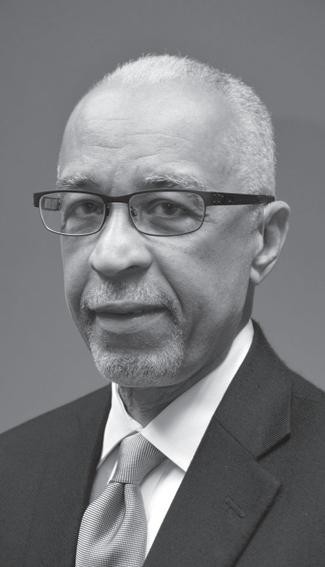
Capitalism is an economic and political system in which a country’s trade and industry are controlled by private owners for profit. Laissez faire translates as “leave us alone,” meaning that the government should allow individuals to freely carry out their own economic affairs. The normative economic policy of the United States is that the economy should be controlled by a small class of individuals and operated for their private profit. Any benefit derived by anyone else is a fortunate unintended consequence, and any damage done is a collateral cost of doing business. The government’s role is to protect the prerogatives of this economic elite. The only rationale for any economic activity in the United States is to generate a profit for some private interest, and you as a citizen only have access to what you can pay for.
What about things that are essential to everyone? These are public goods to be provided
to all members of a society that any individual can consume without reducing the availability to others. Examples are roads and bridges, public education, public parks, sewer and water systems, courts, law enforcement, national defense, and clean air. The reason any government exists, from an absolute monarchy to a direct democracy, is to provide public goods.
In 1776 Thomas Jefferson wrote that there is an inalienable right to life, liberty and the pursuit of happiness and that the purpose of government was to secure these rights. In 1789 Gouverneur Morris declared in the preamble of the new U.S. Constitution that one of the purposes of government was promotion of the general welfare. (Neither the Declaration of Independence nor the Constitution mentions capitalism.)
There can be no right to life or promotion of the general welfare without access to healthcare. A government that fails to provide a public good so essential to the wellbeing of its citizens has forfeited its legitimacy. And, as Jefferson noted, the people have the right to alter or abolish such a government.
A system of private, profitdriven healthcare is antithetical to promoting the general welfare and protecting the right to life, liberty and the pursuit of happiness of black Americans (and white Americans, too). Whether you call it a public option or Medicare for all, it must be foundational to whatever the new normal is going to be.
Decades of policies, practices, politics and legal precedent have laid the foundation for much of the institutionalized inequity many observe and experience in St. Louis today. Like many places in America, where one lives in St. Louis is one of the most important indicators of one’s health and life expectancy. Disparities in health and life expectancy are undeniably correlated with inequities in criminal justice, education, employment, housing, income, transportation, and other social determinants of health.
COVID-19’s impact on the black community in St. Louis will be both reflective of and exacerbated by these disparities. While COVID-19 may not discriminate, the systems, structures, processes, resources, and power dynamics that influence health and life outcomes do. Coined as the “political determinants of health,” these are “the instigators of the causes of inequities, the determinants of
L

Empowering me to serve as an incident commander primarily focused on the public health response, engaging Jason Purnell and Andrea JenningsJackson to lead the human and social services response, and working with a diverse range of stakeholders to help inform economic recovery policies are just a few examples of St. Louis County Executive Dr. Sam Page’s leadership in advancing health equity both in policies and through policymaking.
However, the work does not end once a particular policy outcome is realized. Centering health equity in and advancing equity through policy and politics is a continual process that will require stakeholders to remain engaged, to continue to advocate for change, and to hold decision makers accountable.
History tells us that once the fight against COVID-19 is won,
When will we ever learn?
In St. Louis city, this pandemic is proving that when my neighbor is ill, so am I. When our neighbors lack basic human needs, none of us is safe – medically, physically, emotionally, financially, not even spiritually.
St. Louis city has been in crises for decades and we have been fed the same racist, sexist, superiority, party-town attitude. They have sucked the blood from the turnip –taking from city residents while giving away resources for sports, hotels & developers through tax giveaways, gap financing, TIFs, CIDs. Bottom line: GREED with no priorities for the health and welfare of our people. For years we’ve had thousands of un-housed children in the public school system, more people begging, addicted to heroin and a culture of gun love.
Washington University had a 30-year plan to expand into Forest Park Southeast / The Grove. For the 30 years I watched, they deliberately underdeveloped our area with our alderman at their service. Properties were purchased for minimal amounts and kept vacant for 25+ years. The crack epidemic ripped at the roots of this bi-racial community, creating fear and lots of lost children in its wake. Much of the Grove was developed with public money, our infrastructure serves Wash U and employees were given incentives to live here. Yet through those 30 years , Wash U and our officials never once considered providing health care to citizens? A few masks? Some soap? Testing? When will we ever learn?
Kim Jayne, St Louis
Why doesn’t our health count as safety?
“Transit is essential.” That’s what CMT said in their letter
the impact on the black community will be disproportionately devastating. But history also tells us that by listening to the black community, St. Louis has the potential to emerge from the COVID-19 pandemic as a more equitable region. As noted in an important piece recently authored by former U.S. Congressman William “Bill” Clay about one of the most significant health, social and economic achievements for blacks in St. Louis history, “Homer G. Phillips Hospital came into being as the result of a 23-year struggle” and “from the time (the) hospital was dedicated in 1937 until it closed in 1979, the black community was preoccupied with the fight to keep the doors open.”
Achieving health equity in St. Louis will require a willingness from political and civic leaders to engage in what may be difficult conversations about inequities rooted in race, as well as age, gender, sexual-orientation and socioeconomic status, to develop more meaningful and effective coalitions, to eliminate systemic fragmentation and silos, and to invest the resources necessary to dismantle institutionalized inequities.
COVID-19 has placed St. Louis at a tipping point. We must all decide if we will allow inequities in St. Louis to persist and undermine our region’s full potential, or if we will work together toward a more equitable St. Louis that is as good as its promise.
Cora Faith Walker, Esq., MPH, is the director of Policy for St. Louis County Executive Dr. Sam Page and is a member of the Delta Omega Honorary Public Health Society.
All letters are edited for length and style.
last week. I wholeheartedly agree. I usually rely on Metro (less recently since I can work from home), and I appreciate our transit workers’ and Metro’s efforts to keep our system healthy. Sadly, Bi-State Development refuses to fully protect us. While bus and call-a-ride fares have been suspended, and new safety measures like additional cleaning, masks, and backdoor boarding are in place, Bi-State insists that active fare enforcement will continue on Metrolink.
On March 16, I wrote Taulby Roach, CEO of Bi-State, encouraging them to suspend end fare enforcement. On April 1, he replied that it is “a key component” of their safety plan and will not be suspended. Fare enforcement involves officers walking the lengths of multiple trains an hour and checking the fare of every pas-
senger on the train. It is frankly impossible to do this with sixfoot social distancing, and even one interaction with a coronavirus carrier (which is likely considering asymptomatic cases!) puts hundreds of other transit riders and Bi-State employees at risk. All so that Metro can ensure riders (including many essential workers), are paying their $3 fare for the train. Even setting aside past issues with fare enforcement on transit (including many anecdotes of racially disparate enforcement I have seen or had shared with me), Roach insists that fare enforcement is key to “safety” on Metro.
But why doesn’t our health count as safety?
Please read more and sign our petition: STLtransit.org/coronavirus
Mitch Eagles, St. Louis




Spanish Lake resident Lamar Lacy, a senior electrician at BJC HealthCare, walked his dog Coco in Spanish Lake Park on Friday, April 3. St. Louis County closed all county parks at 8 p.m. that day as a public health protection to slow the spread of COVID-19. Lacy said his dog typically walks the same path every day. St. Louis County and city remain under a Stay at Home public health order until April 22.
ArchCity Defenders, Action St. Louis and The St. Louis American teamed up to centralize policy recommendations, updates, and online petitions on a website: www.STLCovidhub. org. Information on the website outlines concerns COVID-19 presents to already marginalized community members, as well as specific policy measures designed to combat the spread of COVID-19 and its disastrous effects.
The website compiles advocacy efforts, several of which have been initiated and authored by ArchCity Defenders, and endorsed by multiple stakeholders throughout Missouri. Two such petitions are currently circulating. One is directed towards Missouri public officials urging them to implement several Calls to Action on behalf of people who are unhoused, the working poor, people who are incarcerated, and people with disabilities. The second petition targets the chief justice and judges of the Missouri Supreme Court, urging them to prevent the spread of COVID-19 in jails by ordering the release of people who are held in city and county jails.
For more information, visit www.STLcovidhub.org.
The Ferguson Consent Decree monitor cancelled the status hearing set for April 23 as a result of the ongoing COVID-19 crisis. The community will be notified as soon as the next status conference has been scheduled.
Conduent Healthy Communities Institute launched www. covid19atrisk.org to help locate and assist populations that may be at risk of not having basic needs met due to COVID19 stay-at-home orders. This includes people who are older, are at higher risk for severe illness, live below poverty level and/or have children participating in Supplemental Nutrition Assistance Program with data and mapping at the state, county, zip code, and census tract level. Visit www. covid19atrisk.org to access these maps for response efforts.

The world was first made aware of a coronavirus case in China last December. The U.S. was hit with its first confirmed COVID-19 case on January 20. Still, there is no comprehensive, coordinated national plan to stop the deadly virus, which I put squarely at the feet a president who is dismissive of science and facts. The failed leadership of Trump means that the number of U.S. COVID-19 cases now exceeds China – and there’s no end in sight.
The lack of leadership is also being seen at our state and local levels. The drip-drip of vital information over the last several weeks and the inability to take decisive actions are causing confusion, panic and, worse, the loss of human lives.

Sadly, some black voices joined the denial and conspiracy camps. Black actor Idris Elba tested positive for the virus and immediately took to social media to dispel the craziness. Said Elba, “That’s dumb, stupid. All right? That is the quickest way to get more black people killed.” Closer to home, the first deaths related to COVID-19 in St. Louis and St. Louis County were black women. Their deaths triggered my memories about the AIDS epidemic, which was inaccurately rumored at the onset to be a gay disease. It was black women who took the brunt of AIDS on several levels before the appropriate information and preventive actions became widely available.
The fact of the matter is that black people are predisposed to being disproportionately impacted by these kinds of bio attacks. The longdocumented health disparities between blacks and whites in the U.S., along with higher rates of chronic diseases and reduced access to quality health care, make African Americans more vulnerable to COVID19. It’s based upon a racist health care system and a host of cascading racist policies. They are not fixed and unchangeable; these are man-made and can be changed. Adding to the potential deadly equation are poverty, inadequate housing, food insecurity, unemployment or underemployment and so on. African Americans are vulnerable in non-pandemic times. The coronavirus is only intensifying the factors that have always limited our ability to have a quality lifestyle.
In a previous column, “Coronavirus in black and green,” I talked about how the virus would negatively impact black communities. Now we’re hearing from health care providers that black folks are not getting the testing or the treatments afforded to whites. In cities where the pandemic is rampant, hospital officials have hinted that given their capacity and stretched resources, they may have to be more discriminating as to who gets treatment for COVID-19. I can tell you now that elderly, black people will be at the top of the dispensable list.
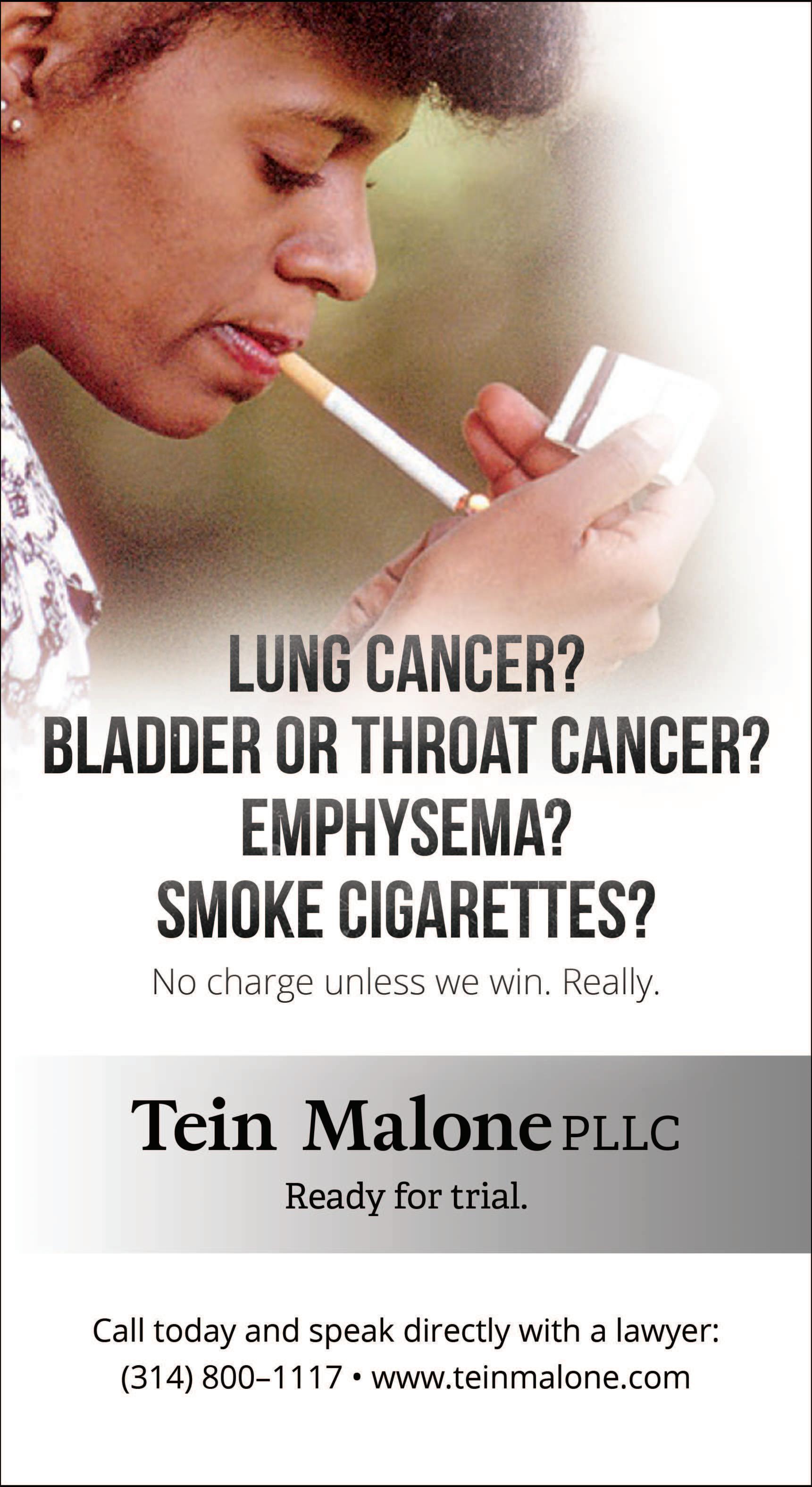
Continued from A1
demic took me right back,” she said. “It was almost like relieving old anxieties and trauma. Everyone lost their jobs. No one knew where the next check would come from. Now today, this pandemic just didn’t take one city under siege, it’s taken an entire world under siege.”
Earlier this year, ThomasMurray had identified 3,095 SLPS students as homeless. “I’m sure those numbers are much higher now,” she said.
This number doesn’t include the students’ family members. She believes two-thirds of the district’s homeless families are “doubled up,” or sharing homes with relatives or friends. About one-third are in shelters or motels. Unless homeless students are living in a shelter, they don’t fall into the federal government’s definition of homeless, which spurs funds for emergency shelter. According to the St. Louis Area Regional Commission on Homelessness (SLARCH), there are at least 780 people who do meet that federal definition of homeless currently engaged with St. Louis city nonprofit organizations, which track their data in real time.
Continued from A1
Eastern District Chief Judge Rod Sippel said Judge Shaw will be “sorely missed” by his colleagues and friends at the court.
“We lost a thoughtful jurist and a courageous voice for justice,” Chief Judge Sippel said. “Judge Shaw’s legal career and time spent in service to the State of Missouri and our country serves as a shining example for all those fortunate enough to take the bench.”
Outreach operations suggest that there are at least 200 more people without homes in the city. Normally, there are 518 beds available for the homeless in the City of St. Louis, according to SLARCH. However, with social distancing requirements, that has been reduced by 40 percent to about 308 beds.
In response to the pandemic, there have been 101 additional beds that City of Hope is operating — 75 winter overflow beds that have been brought back online and 26 beds at the former Little Sisters of the Poor building on Florissant Avenue. Additionally, Steve Conway, chief of staff for Mayor Lyda Krewson, said the city has been working on finalizing contracts on 50 additional beds at hotels. And there is a potential of 100 more beds at the Little Sisters location, he said. Even with these additional beds, Thomas-Murray said, “This isn’t even realistic.”
Soon the families that are doubled up are going to quarrel because the needs will be so high — as she recalls from her own experience living in a two-bedroom apartment with five families. She went to stay in a shelter, and many others will too.
Thomas-Murray is also concerned about the “unaccom-
panied youth” who graduated from the district, went off to college and are now back in the city with no place to go. There are about 500-600 of these youth who aged out of the foster care system or were “runaways,” she said.
“Those are the kids that couch surf,” she said. “They don’t have a leaning post.”
Advocates for the homeless say the pandemic is shining a light on inefficiencies that have caused a lag in the City of St. Louis’ response and ability to enact a plan as quickly as other communities. However, experts say that in the next 10 days, the St. Louis region will reach its peak in the pandemic and action needs to be taken immediately.
“The key is to focus even more so on vulnerable communities — particularly members of the long-term care facilities, the unhoused and immigrant and refugee populations,” said Dr. Will Ross, who serves on the city’s Joint Board of Health and Hospitals. “The next two weeks are where our efforts should be.”
‘We need to pool our strengths’
SLARCH said that 40 percent of the homeless population will be infected by the virus, which Dr. Ross agreed with.
The City of St. Louis has the highest homeless population in the region and will need 600 additional beds during the COVID-19 pandemic for isolation, quarantine and social distancing, according to SLARCH’s data. St. Louis County, which has a smaller homeless population, has already enacted a plan to have quarantine/isolation capacity of 300. The city, which currently has no quarantine beds, is referring all people without homes who are COVID-19 positive to St. Louis County.
“However, their capacity will be overwhelmed in the coming weeks,” according to SLARCH.
Conway said one of the barriers for getting more beds is that agency members that make up the Continuum of Care (CoC) — which consists of organizations, social service providers and individuals who aim to end homelessness — have not “stepped up” to staff the additional shelter locations.
“We’ve been begging people at the CoC to help us find someone to staff these operations,” Conway said. “We’ve asked three or four times. We are offering to pay good money to get things staffed. We can’t put people in place without that.”
However, Shanna Nieweg, chair of the CoC and executive
director at Horizon Housing Development Company, said the accusation requires some context.
“We originally reached out to [the mayor’s office] before we got our first case in St. Louis and said, ‘We need to get together and come up with a plan because this is going to hit the city and our most vulnerable population is going to be targeted by this and we need to have supports in place,’” Nieweg said. “We were not involved in those conversations.”
Instead, she said the city started its task force with the departments of Health and Human Services. So the CoC — which includes 148 agencies — started its own task force.
Nieweg said many people are confused about what the CoC is and does. Every year the CoC’s members voluntarily fill out paperwork required to ensure that the City of St. Louis is in federal compliance to receive HUD funds. However, the city receives the funds and disperses them, with some input from the CoC. However in other communities, CoCs receive the funds and disperse them, Nieweg said.
“The CoC is this magical box they can blame,” she said. “We do not hold the funds. We are doing the work.”
So when the city’s pandemic
taskforce reached out to these providers, she said, they wanted these agencies “who are already stretched thin with their own staff” to give additional support in a “minute’s notice.” Nieweg said, “This isn’t feasible.”
SLARCH’s Timothy Huffman made an “important” call of action on April 14, during the aldermanic Health and Human Services Committee’s virtual town hall meeting on the unhoused. By the end of the week, there needs to be a conversation that includes members of the city’s health department, the behavioral health and human services networks, the city’s Department of Human Services, and the CoC. “You can’t just put a Request for Proposals out to the nonprofit community and say, ‘We need someone to run a quarantine shelter,’” Huffman said. “We don’t know how to hire staff and train medical staff, but the health department doesn’t know how to run shelters. So we need to come together and pool our strengths.”
Huffman said this is what has made St. Louis County’s response so successful. Dr. Ross applauded the request and said, “I think that is the highest priority.”
“I recommended him for the federal judgeship and President Clinton appointed him because of his brilliant legal background in the courts and his sterling participation in other government agencies,” Clay told The American Former President Bill Clinton told The American he “will always be proud to have nominated him to the federal bench and grateful for his extraordinary service.”
“Judge Charles Shaw leavened justice with mercy and
Judge Shaw was appointed to the United States District Court by President Bill Clinton in 1993 and achieved senior status in 2010. He was recommended by William L. “Bill” Clay, then the congressman in Missouri’s 1st Congressional District.
helped make St. Louis and America fairer and stronger,” Clinton told The American Judge Shaw began his judicial career in 1987 when he was appointed Missouri Circuit Judge for the City of St. Louis. As an attorney, he was formerly employed at the National Labor Relations Board, the Lashly Carothers Law Firm (now Lashly Baer) and as an assistant United States attorney. Judge Shaw was born in Jackson, Tennessee on December 31, 1944 and raised in the Ville neighborhood in North St. Louis. He graduated from Sumner High School, earned his B.A. at Harris Stowe Teachers College, his M.B.A. at the University of
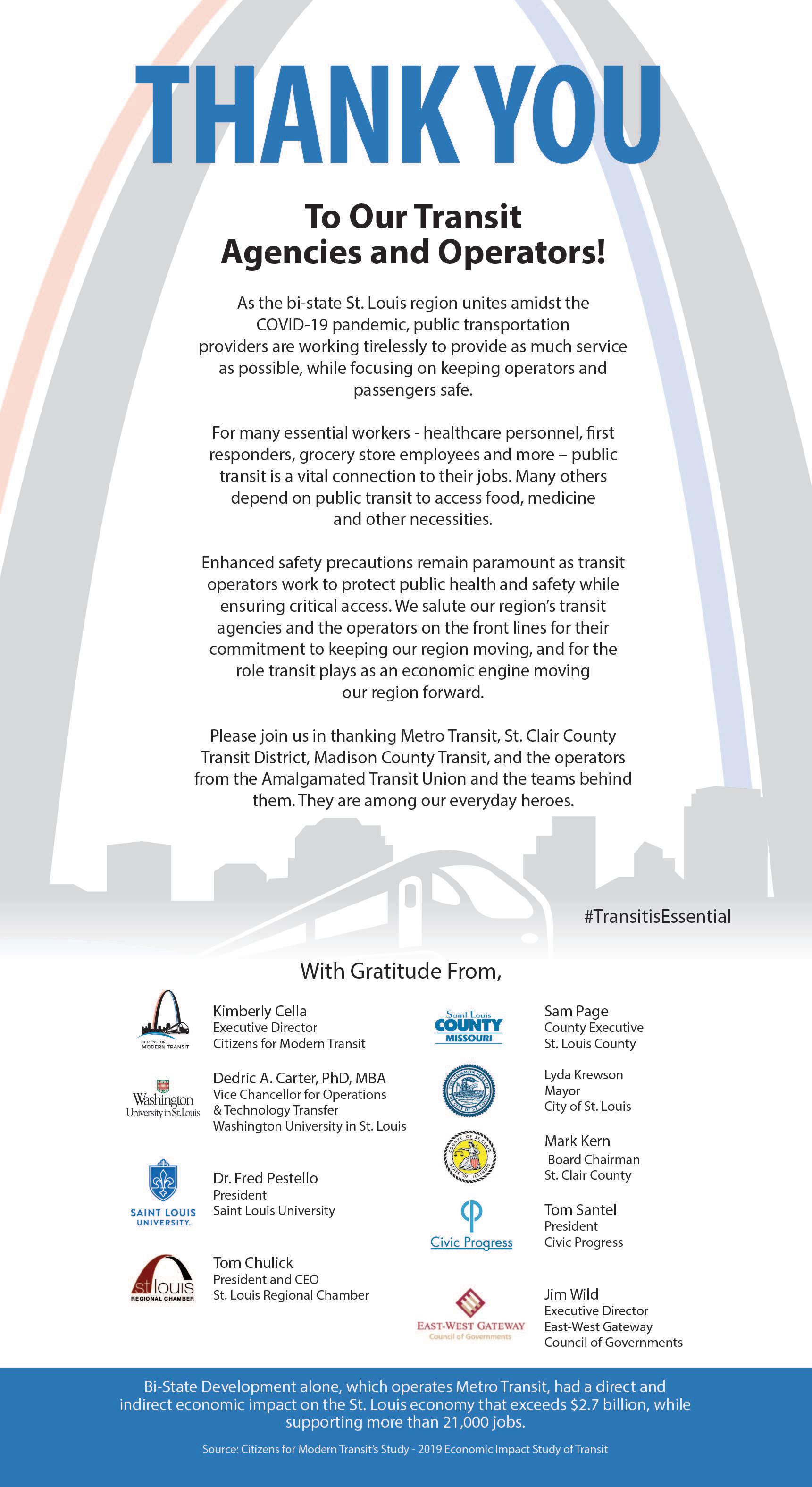
Missouri in Columbia, and his J.D. at Catholic University in Washington, D.C.
In 2013, he published his memoir “Watch Everything: A Judicial Memoir with a Point of View.”
He served as a board member of the People’s Health Center, the St. Louis Art Museum, the Arts and Education Council, Cardinal Ritter College Prep and the Metropolitan Amateur Golf Association. He was a charter member of the Guardsmen and Sigma Pi Phi Fraternity (Eta Boule’).
In his personal life, Judge Shaw dearly loved his family, friends, golf, travel, and the occasional amusing story. He
often remarked that his dreams had been fulfilled: for family, friends and success.
“Rarely a Saturday golf outing would pass without Chuck passing out an article from a good or bad decision in the court or some other injustice,” Virvus Jones remembered.
Judge Shaw is survived by his wife of over 50 years, Kathleen I. Shaw, their son, Dr. Bryan I. Shaw, daughter-inlaw, La Misa, 3 grandchildren, Sydney, Brycen and Braylen, his brother, Booker T. Shaw, sister-in-law, Jane B. Shaw, and many other relatives and friends.
A memorial service will be held in the future. Memorial donations may be made to the
Urban League of Metropolitan St. Louis and the St. Louis Black Repertory Theatre.
“I will miss him greatly,” Judge White said.
“Shaw was part of a new, young generation of professional black leaders who inspired other blacks to reach beyond what was usually expected of them. He offered through example of his personal accomplishments what they could achieve and to what heights they could attain,” Clay said.
“Although he will be greatly missed, our society will continue to benefit from the contributions of the many that he influenced.”
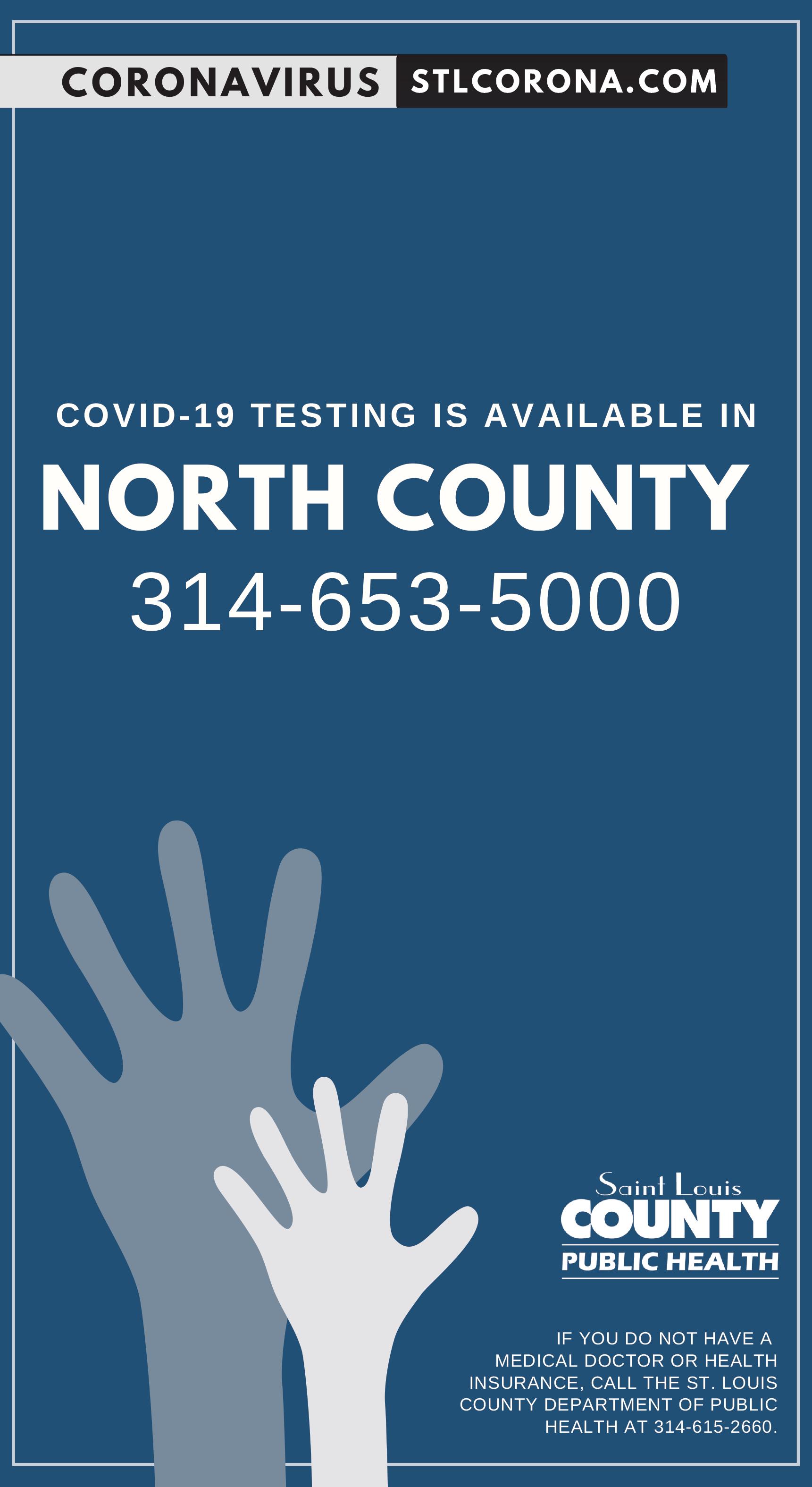
Continued from A1
days,” he said during his April 15 briefing. “The spread of this pandemic is quite real.”
Garza reported on April 15 that there were 175 people in the intensive care unit (ICU) and 149 were on ventilators. There were 59 people who recovered and were discharged.
Garza anticipates that the region will see its peak in COVID-19 cases at the end of April, though predicting this is similar to forecasting when a hurricane will hit, he said. At the region’s peak, anywhere from 600 to 1,500 people could be hospitalized at any one time.
Based on the task force’s projections, Garza estimates that more than 71,000 people of the region’s 2.8 million
Continued from A1 their learning.
• engaging our students in quality virtual learning experiences.
• providing support to your family academically and emotionally, so that you don’t have to navigate these changes alone.
• protecting the health and safety of our students, families and employees.
• leveraging our resources equitably so that everyone, including our most vulnerable students, can thrive.
• striving toward excellence, even during this undeniably challenging time, so that we reemerge better and stronger at
people could be infected with the virus by the end of April — though about 30 percent will be asymptomatic.
“That is down slightly from our initial estimate of more than 80,000, and it is a reflection that all of the things we have been doing — including shelter in place, social distancing and other actions — are helping,” he said. “But this is still a significant number.”
Experts hope St. Louis will have similar success as it did with the 1918 influenza pandemic, but most people don’t realize that it came in three waves after officials relaxed social distancing, Garza said. “We can’t afford a second wave – or a third wave – in this pandemic,” he said. “We need to throw everything we can at this virus in the weeks ahead to stop the spread.”
During the April 10 briefing,
its conclusion.
This rapidly changing situation means we must work through challenges complicated by coronavirus safety mandates. So far, we have received nearly 10,000 requests for iPads or hotspots and prepared and/or distributed more than 5,400 devices. We are working quickly, but ask for your patience, as we process all of the requests.
If your family is still in need of a device or hotspot, please complete the technology survey at www.slps.org/tech or contact your child’s principal or the Special Education Department at 314-633-5325 or 314-3452491.
Our educators are working tirelessly behind the scenes to rewrite lesson plans for virtual learning, update school web-
Garza reflected on conversations he’d had with some of the frontline medical workers.
“What I saw and heard was truly surprising,” Garza said. “I was told that people were requesting to work on dedicated COVID units. When I asked the staff why they wanted to work on COVID units, they told me different things. Some said, ‘This is what we do, this is what I went into healthcare for, and this is where I’m needed most.’ It was an inspiring experience.”
Garza also said that the task force now has a liaison officer who is working with five Missouri emergency operations centers: St. Charles, City of St. Louis, St. Louis County, Franklin County, Jefferson county.
Also, the alternative care facility at a Quality
Inn in Florissant opened on Wednesday, April 15. This is for COVID-19 patients who have mild symptoms and a means for people who are recovering, if they need someplace to quarantine, he said.
As of April 15, St. Louis County had reported 58 COVID-19 deaths and 1,896 cases, and St. Charles County had reported 17 deaths and 413 cases. As of April 14, the City of St. Louis had reported 26 deaths and 723 cases. At press time, the State of Missouri had reported 147 deaths and 4895 cases since the onset of the pandemic.
‘Practice self-compassion’
During the April 10 briefing, Garza invited a mental health expert, Dr. Timothy Bono, to give tips on mentally dealing
Please make sure your child’s principal has your current phone number and email address so that you don’t miss any information.
Reach out to your teacher or principal to ask questions or get updates. If you aren’t able to make contact, call 314-437-8430 for assistance.
If your family is still in need of a device or internet hotspot, complete the survey at www.slps.org/tech or contact your child’s principal or the Special Education Department at 314-633-5325 or 314-345-2491.
For more information, visit www.slps.org.
Kelvin R. Adams is superintendent of Saint Louis Public Schools. Dorothy Rohde-Collins is president of the Board of Education of the City of St. Louis.
sites, adapt to learning new technology and contact every student regularly. As you can
imagine, this is a major adjustment, and it will take a bit more time to refine the process,
with the pandemic. Bono is the assistant dean in the College of Arts & Sciences and lecturer in psychological and brain sciences at Washington University.
Bono gave tips on three positive “behaviors” and two mindsets.
The three behaviors were restoring a sense of autonomy, working towards goals, and finding a sense of relatedness.
“It can feel like things are spiraling out of control,” Bono said. “It becomes important to focus on things that are in our control.”
These things include getting exercise regularly, cooking favorite meals, watching favorite shows, and expressing gratitude for the things that are going well in our lives and communities, Bono said.
Second, it’s helpful to
but this commitment to upgrading our technology and skills will positively impact how we teach and how students learn both now and in the future.
In the meantime, please don’t hesitate to reach out to your teacher or principal to ask questions or get updates. If you aren’t able to make contact, please call 314-437-8430 for assistance.
Over the coming weeks, you can expect regular communications from both the Central Office and your child’s school regarding learning assignments, year-end traditions like prom and graduations, summer school and the 2020-2021 school year. Our website (www.slps.org) will always have the most current information, but we’ll also be utilizing automated calls,
work towards goals that give people a sense of accomplishment — no matter how small. That can be eating a healthy breakfast or making the bed every day.
“Even a small goal can motivate us to accomplish larger goals later in the day,” he said.
And third, maintaining relationships is one of the most important ways to maintain mental health at any time but especially during a crisis. The two mindsets are to give yourself permission to be human and to take one day at a time.
“Allow yourself to feel whatever you are feeling,” Bono said. “There will be days we are not able to make enough progress towards our goals. It’s important to practice self-compassion.”
email and social media to make announcements.
Please make sure your child’s principal has your current phone number and email address, so that you don’t miss any information.
We know this is a stressful and emotional time – it is for us also. We miss being able to welcome you into our buildings and providing learning experiences every day. However, our mission to provide a quality education for all students remains unchanged. We’ll see you back at school as soon as we are allowed to reopen our school buildings.
Until then, let’s all work together to stay safe while we learn together – at home. For more information, visit www.slps.org.
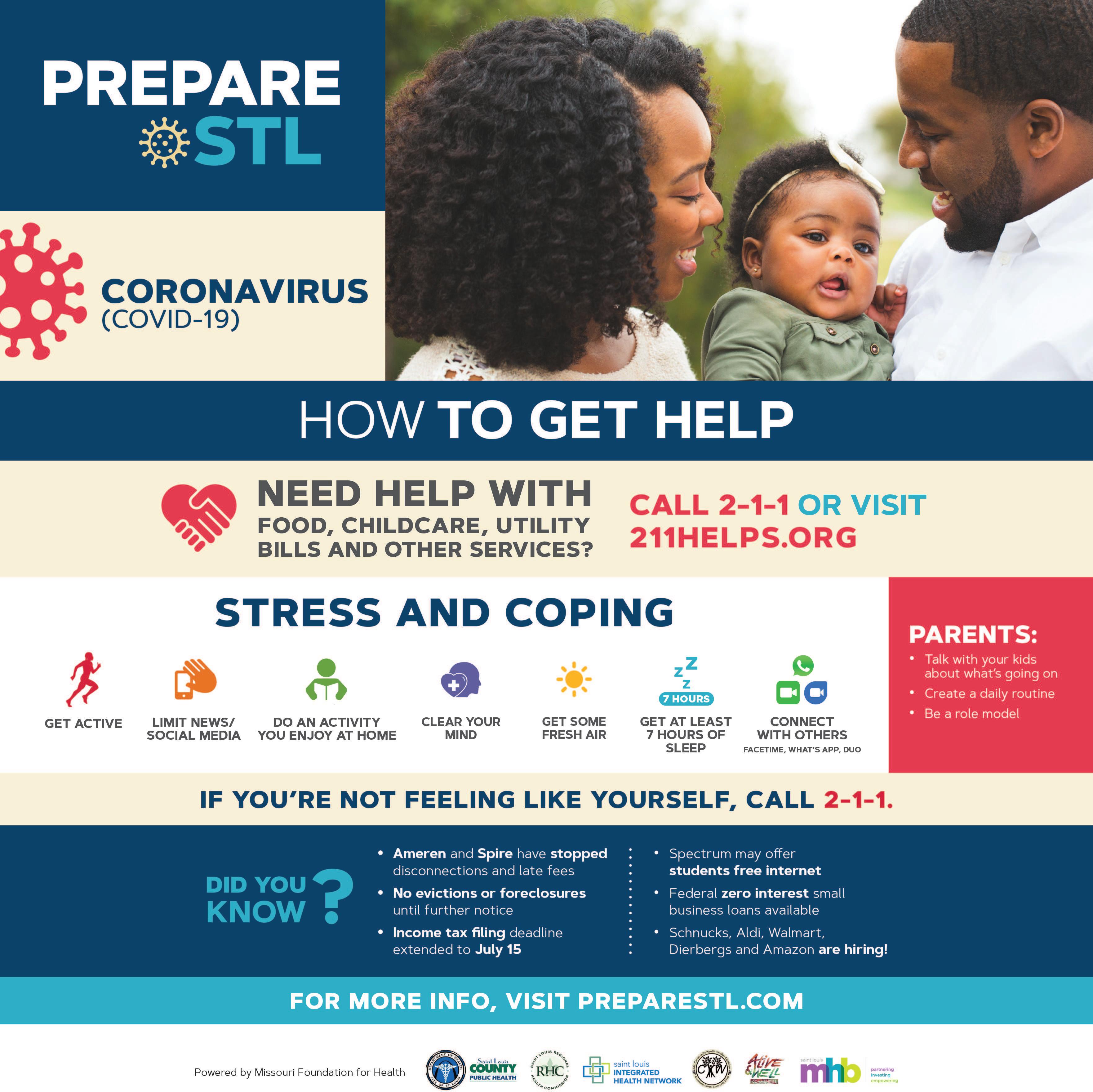
Racialized disease during the COVID-19 pandemic
By Chelsey Carter and Ezelle Sandford III
The St. Louis American
For
As the novel coronavirus disease 2019 (COVID-19) pandemic sweeps across the world, troubling associations between race and disease have gone viral.
On social media, theories of black people’s immunity to COVID-19 spread rapidly and widely, with the initially small number of cases in Africa often cited as evidence. Since then, the virus has spread to the continent and will surely exacerbate already compromised health systems.
The virus was also erroneously labelled as the “Kung Fu Flu” and the “China Virus,” among other epithets, by members of the Trump administration—including the President himself. While these labels may have the air of jest, white supremacists have sought to use the novel coronavirus for bioterrorism, targeting racial minorities.
Claims of immunity falsely suggest that black people cannot contract the disease. Meanwhile, labels that construct the disease as Chinese obscure the vital pathways the contagion has taken irrespective of racial categories. These claims are more than just racist and xenophobic—they are dangerous to everyone’s health.
It is times like these, amid existential fear and anxiety, when we must be most attuned to the ways in which race is deployed, to the historical origins from which these ideas emerge, and to how these ideas undergird social fear and political inaction.
Race has no biological basis. Rather, it is historically, politically, culturally, and affectively produced not only by systems and structures, but by moments. The embedded effects of oppression, marginalization, and racism have very real biological consequences. We must consistently ask ourselves: What does the racialization of disease reveal and what does it occlude? What meanings do we attach to a condition and create in these processes of racialization? How do these meanings impact people’s day-to-day lives?
COVID-19 is an infectious disease caused by the novel coronavirus, SARS-CoV-2. The disease causes respiratory illness with symptoms such as cough, fever, and in more severe cases, difficulty breathing. This virus disproportionately impacts the elderly and people with certain preexisting conditions. We know that 50 to 129 million non-elderly Americans have such conditions. This figure increases substantially when you consider individuals over the age of 55. Black, brown, and Indigenous communities bear a disparate burden of these conditions.
We know that COVID-19 will disproportionately impact communities of color. The racialized experience of COVID-19 will be further exacerbated at the intersections of class, gender, and age. Assertions of black immunity to COVID-19 represent the persistent afterlife of slavery and the pervasive power of white supremacist thought. As historian Rana Hogarth argues, these theories emerged in the era of enslavement, as the system itself made such observations of racial difference possible in the Atlantic world. According to Hogarth, “Slavery apologists would, of course, eventually use this claim to suggest that Black people’s peculiarities were a sign of their fitness for servitude.”
While a pandemic of this size and scope is unprecedented in our generation, the world bore witness to major outbreaks of the past. Black immunity theories emerged, perhaps most prominently, in Philadelphia in the late eighteenth century in the face of successive Yellow Fever outbreaks.
Prominent Declaration of Independence signatory and abolitionist, Dr. Benjamin Rush, ardently believed that African Americans were immune to the disease as a result of their purportedly acclimatized bodies. In Philadelphia, Rush worked with African Methodist Episcopal ministers Absalom Jones and Richard Allen to recruit the city’s free black community to care for dying white citizens. When African Americans themselves succumbed to disease, their suffering was ultimately erased, unexplained by immunity. Even today medical students are taught to quickly associate disease with racial and ethnic identity. Sickle Cell Anemia is associated with African Americans, Cystic Fibrosis with European descendants, and Tay-Sachs disease with Ashkenazi Jews. While these shorthand associations facilitate consultation speed and efficiency, they are dangerous and sometimes fatal.
A classic case of the consequences of associating race and disease has been shared widely by legal scholar and critical race theorist, Dorothy Roberts. Roberts recounts a Pediatrics journal article on the misuses of racialized diagnosis when a young Black girl repeatedly returned to the emergency room for pneumonia or respiratory concerns over a

six year period. At a subsequent ER visit, the 8-year-old’s x-rays were examined by a radiologist, who exclaimed, “Who’s the kid with cystic fibrosis?” Her medical records illuminate a narrative of racialized assumptions that rendered her invisible to the myriad clinicians who treated her over the years.
Diseases without clear etiologies—like ALS, which has been dubbed a “white” disease—often accrue false, racialized narratives as well. Scholars have discovered that Western medicine’s beliefs that particular races cannot contract certain disease does not just impact patient diagnosis or misdiagnosis but impacts the entire care system.
While some scientists and physicians rely heavily on associations between race and disease, less attention is devoted to serious analysis of the social determinants of health, i.e. the structural forces that often lead to disparate disease burden in racial minorities. A preliminary paper by a group of epidemiologists in Wuhan, China drew on myths about minority immunity based on blood type, claiming, “#COVID19 deaths likely higher in Europe but less so in Asia/India (more B) or Latin Americans (more O).”
Yet, who was the first person to die of COVID-19 in Brazil? A Black female domestic worker
The first person to die of COVID-19 in St. Louis County was an older Black woman who worked as a nurse
Those who are the most invisible, most marginalized, and who lead the most precari-

ous lives will be the ones most affected by COVID-19. They certainly are not always the first individuals diagnosed, but they are usually the first to die COVID-19 spread globally for two chief reasons: a particularly high R0, the “reproduction number” indicating how contagious an infectious disease is, and individuals who had access to resources which allowed them to travel. Thus, in locations like St. Louis, the first case of COVID-19 emerged in a white-majority county suburb—a white student was infected in Italy before returning to St. Louis. Early on, it was easy to joke that the virus was a “white disease.” And then a black woman succumbed first.
When we consider the afterlife of slavery, ongoing medical racism, global histories of medical mutilation and experimentation, and black invisibility within white supremacist medical systems—asking why black people would joke about our own susceptibility is warranted. Theories of black immunity sound like the perfect reward for generations of racialized violence, amid a dystopian global nightmare. The reality is, regardless of diagnosis, we are particularly susceptible and arguably among the most vulnerable.
In an effort to find control in chaos, racialized claims like black immunity ultimately represent a scrambling for power and a desire to make sense of
uncertainty. We deploy these ideas which ultimately play into our own oppression and the oppression of others, however. Although the history of race and the cultural innovations created in response to oppression, do give communities of color resilience in the time of great anxiety, racialized rhetoric about diseases can be dangerous for your health. This language is as dangerous when black people co-opt it. COVID-19 has no demonstrated biological association with any racial or ethnic group–viruses do not discriminate. In fact, the virus has the ability to infect us all, and will inevitably indirectly touch each and every human life in the world. Its most severe impact will be on those who are most socially vulnerable—the incarcerated, the unemployed, the unhoused, the uninsured—groups in which black and brown individuals are disproportionally represented. Racializing disease on those grounds alone has no impact other than to promulgate dangerous assumptions. Seemingly banal claims of “black immunity” may bring some semblance of humorous communal bonding, but they are not funny.
Chelsey Carter is a doctoral candidate in Anthropology and Master’s in Public Health candidate at Washington University in St. Louis. Ezelle Sanford III is a postdoctoral Fellow in the Program on Race, Science, and Society and project manager for the “Penn Medicine and the Afterlives of Slavery Project” in the Center for Africana Studies at The University of Pennsylvania. Edited for length and reprinted with permission from the African-American Intellectual History Society’s award-winning blog, Black Perspectives, https://www. aaihs.org/racializeddiseaseandpandemic/.


As the COVID-19 pandemic brings extraordinary challenges to the St. Louis region, physicians and health care leaders from BJC HealthCare, Mercy, SSM Health and St. Luke’s Hospital remain united in their mission to support the community through this difficult time. We are working in close partnership with local and state health departments and our academic medical institutions, Saint Louis University and Washington University Schools of Medicine.
We know that preparation, cooperation and participation by the entire St. Louis community will enable us to weather the COVID-19 pandemic together.
ST. LOUIS METROPOLITAN PANDEMIC TASK FORCE
In an innovative and expanded collaboration, BJC HealthCare, Mercy, SSM Health and St. Luke’s Hospital have formed the St. Louis Metropolitan Pandemic Task Force with the goal of slowing the transmission of COVID-19 and saving lives across the St. Louis region. The task force also is coordinating with public health departments, elected leaders and state and federal agencies.
Information from other countries and U.S. areas impacted earlier in the pandemic, along with data from the Centers for Disease Control and Prevention (CDC) and state and local health departments, strongly indicate that the St. Louis region will see a surge of COVID-19 patients within the next two weeks. The surge will undoubtedly put a strain on our health care resources.
Our task force is working together to coordinate capacity, staffing, supplies and other critical assets to prevent that surge in patients from overwhelming the region’s health care resources.
We also are coordinating with public health departments, elected leaders and state and federal agencies to make sure area residents have factual, current information and access to the best possible care. The St. Louis Metropolitan Pandemic Task Force holds daily press briefings at 3 p.m., streamed live on its Facebook page facebook.com/ St-Louis-Metropolitan-Pandemic-Task-Force
Alex Garza, MD, chief medical officer for SSM Health, serves as incident commander for the task force. A former assistant secretary and chief medical officer for the U.S. Department of Homeland Security, Dr. Garza led the U.S. response to the H1N1 pandemic.
Dr. Garza and the rest of the task force stress that while our planning is vital to preparing for the upcoming surge of patients, it’s the actions of area residents that will ultimately determine how the St. Louis region fares in the fight against COVID-19.
“The next 10 days to two weeks are critical,” Dr. Garza says. “Our hospitals are already working to save lives and doing heroic work. But what we do as individuals will directly reduce the number of patients into our health care systems and impact whether our health care providers are able to manage the curve. What we do as individuals will affect how many people get sick — and how many people are able to recover.”
As members of the St. Louis Metropolitan Pandemic Task Force, we also are partnering with other local organizations to get crucial information and resources into at-risk communities.
BJC, Mercy, SSM and St. Luke’s are supporting the City of St. Louis and St. Louis County Health Departments, the St. Louis Regional Health Commission, St. Louis Integrated Health Network, the Missouri Foundation for Health and other organizations in a unified communications and outreach campaign called “Prepare STL.”
The best way to increase everyone’s chances of staying healthy is simple — just stay home. COVID-19 is spread from person to person, so limiting the people you physically interact with lowers your risk of contracting the virus.
Here are some stay-at-home guidelines for every household:
• Keep 6 feet away from others. This helps you avoid the respiratory droplets spread by sneezing or coughing that spread the virus.
What we do as individuals will directly reduce the number of patients into our health care systems and impact whether our health care providers are able to manage the curve.
Through the initiative, Prepare STL is reaching out to the area’s most vulnerable communities during the pandemic to share crucial information about COVID-19, including social distancing recommendations, proper handwashing instructions, symptoms to watch for, what to do if symptoms occur, how to access testing and more.
Over the next several weeks, Prepare STL is reaching these communities through neighborhood visits, TV commercials, social media information and literature posted in prominent places.
Vulnerable communities at highest risk have been identified for direct visits through street canvassing and mobile outreach. In these areas, Prepare STL will send individuals and information to nearly 700 community locations, such as grocery and convenience stores, gas stations, pharmacies, health centers, laundromats, bus stop shelters and other public locations as needed.
The community canvasses began this week and will continue over the next several weeks, with the distribution of posters, signs and flyers.
• Wash your hands frequently.
• Disinfect the surfaces you touch frequently, like kitchen counters, doorknobs and toilet handles.
• Avoid touching your face, nose, mouth and eyes.
• If you can work from home, do so.
• Avoid social gatherings of 10 or more people.
We know that with your help, the St. Louis community will emerge from this challenging time stronger than ever.
FOR MORE INFORMATION ON COVID-19 AND RELATED ISSUES, CALL OR VISIT:
Missouri Department of Health 877-435-8411
Illinois Department of Health dph.illinois.gov/covid19 FOR ADDITIONAL INFORMATION: cdc.gov/coronavirus/2019-ncov who.int/emergencies/diseases/novelcoronavirus-2019 bjc.org/coronavirus mercy.net/covid19 ssmhealth.com stlukes-stl.com
Clay Dunagan, MD, MS Senior Vice President and Chief Clinical Officer
Keith Starke, MD Senior Vice President and Chief Quality Officer
Alexander Garza, MD, MPH Chief Medical Officer
William Campbell, MD Infectious Disease Specialist and Medical Director

“TakingCareofYou”
J.D. Coats, 77, a retired resident of Spanish Lake, walked the path around Spanish Lake Pond on Friday, April 3. St. Louis County closed that and other county parks at the end of that day until further notice to slow the spread of COVID-19. The CDC also issued recommendations for people to wear protective masks in public after county parks were closed. However, safe daily exercise during the pandemic is recommended for physical and mental health.

‘There are still people not taking this virus seriously’
PrepareSTL tries to slow the spread of COVID-19 in high-poverty Zip codes
Starting the weekend of April 11, canvassers, outfitted in personal protection equipment, are going to high-visibility community hotspots in the St. Louis region, such as grocery and convenience stores, gas stations, laundromats, and check cashing businesses. They are placing posters, sandwich boards and flyers at these locations, warning about COVID-19 and reminding the community how
By William F. Tate IV and Kally Xu
For The St. Louis American
David and Goliath, MJ and Scottie, the Blues Brothers, Frodo and Sam, salt and pepper, and grits and eggs rank as top duos in religion, sport, comedy, film, cuisine, and culture. St. Louis is a baseball town.


Many fans will recall arguably the best double play duo in baseball history—the Big Red machine’s Joe Morgan and Dave Concepcion. And St. Louis’s own Ozzie Smith and Tommy Herr as a duo represent one of the more formidable infield combos in the game’s history. All of these pairings were intended to offer life lessons, enjoyment, or opportunities for friendly debate as they remind us of our humanity. However, not all pairings generate a positive response. If you think Bonnie and Clyde, robbery and death come to mind. Today, we face a pandemic associated with a novel coronavirus and the disease it causes, COVID-19. This disease robs us of our health. And if paired with an underlying health condition, this duo has proved to be fatal. What is an underlying health condition? Another pair helps to describe the term—chronic and immunocompromised.
to slow its spreads. Zip codes with the highest poverty rates have been selected for the community canvassing. Many are in North St. Louis City and County, including 63106, 63107, 63115 and 63120 in the city and 63136 in the county. Their efforts are part of a campaign called PrepareSTL, organized by the Regional Health Commission, the City of St. Louis Department of Health and the Saint Louis County Department of Public Health and powered by Missouri Foundation for Health.
“There are still people not taking this virus seriously and we want everyone to be prepared to handle it,” says Angela Fleming Brown, CEO of the Regional Health Commission, which exists to improve the health of the uninsured and underinsured in
Chronic conditions include long-term diseases such as hypertension (treated and untreated), diabetes, asthma, chronic bronchitis, cancer, liver disease, chronic obstructive pulmonary disease, heart disease, and cancer. Immunocompromised encompasses all conditions that weaken the immune system. Lupus, HIV/AIDs and pneumonia affect the immune system. Chemotherapy or steroids suppress the immune system. Currently, the relationship between COVID-19 and underlying health is being monitored by public health officials in the United States. So far, there is a large gap in data available in regards to patients with underlying health conditions and other known risk factors. As of March 28, according to the Center for Disease Control’s (CDC) Morbidity and Mortality Weekly Report, only 7,162 cases, or 5.8%, of the
Symptoms may appear without infection
By Chris King Of The St. Louis American
Since the first appearance of COVID-19 in the St. Louis region in early March, the community has expressed impatience with the amount of information about cases reported by public health agencies. The problem is partly endemic to a democracy with protections for personal privacy; public health agencies are limited in what they can report, even during a pandemic when information can save lives. In this pandemic, the problem has been compounded by a chaotic testing situation, with tests being performed by public and private facilities. To address this problem, St. Louis County Executive Same Page issued an executive order requiring private companies to immediately report the results of all COVID-19 tests, positive and negative. Public health agencies have experienced difficulty in getting timely reports from private testing facilities, particularly of negative test results. Negative test results,
n Symptoms are an unreliable indicator of whether someone is infected with this virus. Screening for an isolated symptom – like temperature – provides only an illusion of protection from contagion.
when compared to symptomology, can provide important information.
The good news about a pandemic is that, as it spreads across the world, the disease becomes better known. While the St. Louis region is new to the struggle against COVID-19, other communities have strug-

“You should take the same precautions when interacting with other people that you would when interacting with someone who has tested positive for COVID-19,” Dr. Ngozi Ezike, director of the Illinois Department of Public Health, said on March 15 when there were only 93 COVID-19 cases in Illinois. By April, the state would be reporting more than 1,000 new cases every day.


“TakingCareofYou”
Continued from A10 total number of COVID-19 cases in the U.S. have data available on these conditions and risks. Of these 7,162 cases, 2,692 (37.6%) of the patients reported having one or more underlying condition or risk, while 4,470 (62.4%) reported having none.
Patients with at least one underlying health condition were admitted to the intensive care unit (ICU) or required hospitalization without ICU admissions at higher rates than those with no reported conditions or risks. Additionally, of the 7,162 cases, 184 deaths occurred, 173 of which (94%) were among patients with at least one underlying condition. All of the deaths occurred in patients over 19 years old. Some of the more common underlying conditions reported include diabetes mellitus, chronic lung disease, and cardiovascular disease. These findings suggest that people with underlying health conditions are at higher risk for
severe outcomes with COVID19 compared to those without them.
This data was collected from all 50 states and four U.S. territories, and Washington D.C. (Repatriated cases from Wuhan, China, and the Diamond Princess Cruise Ship were not included in the data analysis.) Public health departments collected data on underlying health conditions through a report form that asks if a patient has any of the following conditions: chronic lung disease, diabetes mellitus, cardiovascular disease, chronic renal disease, chronic liver disease, immunocompromised condition, neurologic disorder, neurodevelopment or intellectual disability, pregnancy, current or former smoking status, or other chronic disease. Because of the small amount of reported data regarding underlying health conditions, this report is preliminary. However, two conditions suggest the findings warrant action.
First, the findings align with reports from China and Italy that suggested risk factors for severe disease include the pres-
ence of one underlying health condition. The second factor is the prevalence of these underlying health conditions in the United States.
Let’s take hypertension. The CDC reported that nearly one-third of the adult population in the United States have been diagnosed with hypertension and/ or are being treated with hypertension medication. This fact indicates a large percentage of the United States population has elevated risk.
Demographic differences in hypertension prevalence rates offer even more insight into the risk of severe outcomes with COVID-19. In relative terms, middle-aged and older blacks experience hypertension at higher rates than non-Hispanic Whites. Blacks develop hypertension earlier than whites, and the disparities in rates of hypertension persist across life course.
n Individuals living with underlying health conditions should maintain at least a 30-day supply of medication, 2-week supply of food, and knowledge of the COVID-19 symptoms.
present in disparate fashion. The CDC reports that diabetes is 17% more prevalent in rural areas than in urban areas. Many rural communities lack the ICU equipment required for supporting the most severe reactions to COVID-19. American Indian/ Native American (15.1%), Hispanic (12.7%), and black, non-Hispanic (12.1%) have the highest percentages of U.S. adults age 18 or older with diagnosed diabetes. Many of these demographic groups live in concentrated fashion in urban and rural communities. Furthermore, millions may face the challenge of being underserved. According to Kaiser Health News, 18 million people reside in counties with hospitals that lack an ICU. Almost 11 million more residents live in counties without a hospital. In both cases, nearly one-fourth of the residents are 60 or older.
Other underlying conditions
Older adults face greater risk of
severe outcomes if they experience COVID-19 due to their age. Many older adults live with one or more underlying conditions.
Disparity rates associated with underlying conditions provide insight into the groups with elevated risk of severe outcomes. These rates are not an excuse for poor prevention practices or for less robust intervention. Prevention measures include hand washing, disinfecting high-touch surfaces, social distancing, as well as avoiding large groups, traveling, and contact with persons experiencing illness.
The CDC recommended that individuals living with underlying health conditions maintain at least a 30-day supply of medication, 2-week supply of food, and knowledge of the COVID-19 symptoms. If you have underlying conditions and experience symptoms of COVID-19, please contact your health care provider.
The CDC recommended that people who are sick should stay home with the sole exception of accessing medical care, especially those who work or interact with people with
underlying health conditions and other at-risk persons. For individuals without underlying conditions, it is important to practice social distancing. Not only does this protect you, it protects our neighbors at higher risk of experiencing severe outcomes from COVID-19. Our community members need to know we have their back. To put it in the words of the iconic pair Sonny and Cher, “I got you.”
William F. Tate IV is dean and vice provost for Graduate Education; Edward Mallinckrodt Distinguished Professor in Arts & Sciences; and faculty scholar, Institute for Public Health, at Washington University in St. Louis. Find him on Twitter @ WFTate4.
Kally Xu is a John B. Ervin Scholar and Gephardt Institute Civic Scholar at Washington University in St. Louis, where she is a candidate in the 3-2 Masters of Public Health in the George Warren Brown School of Social Work and the A.B. program in International and Area Studies and Asian American Studies.
By Milkayla Allen For The St. Louis American
Missouri was facing a healthcare crisis long before the COVID-19 pandemic. Our state legislators have ignored our demands for increased access to healthcare. Now we’re in uncharted waters, and to make it through this crisis as a community, we must center the voices of those most impacted: black and rural uninsured Missourians.
Fortunately, due to the latest legislative package passed by Congress, testing for COVID-19 is now free. The goal, according to the director of Missouri Department of Health and Senior Services, is for Missouri to test basically everyone with a cough and a fever over 100.4. For the nearly 600,000 Missourians currently
Continued from A10
the City and County.
“We want them to understand what COVID-19 is, how to stop the spread and how to survive the shutdown physically, emotionally and economically.” The community canvassing and mobile outreach aspect of the campaign is led by the St. Louis Integrated Health Network, STL Community
Continued from A10
gled against it for months.
Researchers have had an opportunity to move into those communities and make more detailed reports on COVID19 and its impact. What the community wants to know about COVID-19 in St. Louis but is having a difficult time learning in real time is being reported about other communities. There is every reason to expect that their experiences are not only relevant to what is happening here but also predictive of what will happen here. The Centers for Disease Control and Prevention’s Morbidity and Mortality Weekly Report is providing a
living without health insurance, this is a good start – but if it doesn’t come with a plan for affordable treatment, it’s not nearly enough. Black Missourians make up 13.9% of the state’s uninsured population, while only totaling 11.8% of our state’s total population. While the novel coronavirus continues to spread across the region, it is obvious black communities will bear the brunt of the blow if our elected officials don’t act soon. St. Louis city and county recently released data that illustrates the highest concentration of COVID-19 cases on the north side.
Governor Parson and the state legislature have refused to protect our families. The blatant disregard from our elected officials for the health and well-being of our peo-

Health Worker Coalition, Alive and Well Communities, STL Mental Health Board and Emerging Wisdom.
“PrepareSTL provides the City of St. Louis and St. Louis County with a means to reach all segments of our community with COVID-19 messaging, especially those who do not have internet access and those
series of reports from the front line of COVID-19 response. Since these researchers have been granted permission to ask more detailed and invasive questions than local public health officials (in a democracy) may ask in real time, these reports contain valuable clues about what to expect and how to respond.
In its April 3 report, the CDC discusses a COVID-19 outbreak at a senior independent and assisted living community in the Seattle, Washington area, where the first case of COVID-19 in the United States was reported. By the way, that case was reported on January 19, when a 35-year-old man presented to an urgent care clinic in Snohomish County, Washington, after traveling to visit family in Wuhan,
ple is untenable. Our elected officials have decided to drag their feet, and countless lives have been lost. In a moment like this, no individual should be deterred from seeking treatment for fear of crushing medical debt. Our people need Medicaid expansion now. Under the current eligibility requirements for Medicaid, adults without children are ineligible completely, and a parent with a child can’t earn more than $2,900 annually. These ridiculous standards mean that hundreds of thousands of Missourians have fallen into a coverage gap, where they aren’t currently eligible for Medicaid or subsidies

offered to offset the cost of private insurance. The minimum wage in Missouri is $8.60, which means that a full-time minimum wage employee makes an average of $1,200 a month or $15,000 a year. Under Medicaid expansion, any adult who makes $18,000 a year or less will be eligible for Medicaid. The relief this could bring to our state is necessary and urgent. In fact, expanding Medicaid would help over 300,000 families, including the workers who are on the front lines right now cleaning stores, bagging groceries and taking care of our loved ones.
Since 2014, Missouri has
n “PrepareSTL provides a means to reach our community with COVID-19 messaging, especially those who do not have internet access and do not rely on traditional media.”
– Dr. Fredrick Echols, City of St. Louis
who do not rely on traditional media,” said Dr. Fredrick Echols, director of health for the City of St. Louis. They are targeting black Americans, who are dispro-
China. Many people in St. Louis who had symptoms consistent with COVID-19, such as a dry cough and fever, last year persist in believing they had COVID-19. Given the highly contagious nature of the virus and its devastating effects, especially on older people and people with certain health conditions, if someone in St. Louis had COVID-19 last year, we would have started responding to this disease last year, not this March.
The CDC report on the senior independent and assisted living community in the Seattle area has a more complete set of data about a more limited group of tests than we have seen in St. Louis, and important lessons can be drawn from this report.
Among 142 residents and staff members tested for this
portionately dying from COVID-19 compared to other Americans, immigrants/New Americans, low-to-moderate income people, and seniors living in St. Louis city and
study, three of 80 residents (3.8%) and two of 62 staff members (3.2%) had positive test results. A fourth resident, who had negative test results in the initial phase, had positive test results 7 days later. The three residents who tested positive had no symptoms at the time of testing. Both of the staff members who tested positive reported symptoms.
The message is clear: symptoms are an unreliable indicator of whether someone is infected with this virus. Screening for an isolated symptom – like the temperature checks to be admitted into certain public spaces such as St. Louis City Hall – provides only an illusion of protection from contagion. Not only does the absence of symptoms not guarantee health, but the presence of symptoms also does not prove
denied billions of dollars in federal aid, making the weight of COVID-19 even deadlier for its residents. Rejecting these funds led to the closure of 14 hospitals across Missouri between 2014 and 2019. By refusing to expand Medicaid, our state has lost the resources and infrastructure needed to respond to the current crisis. Additionally, over 172,000 people were purged from the Medicaid rolls since 2017, despite meeting all eligibility requirements. Without Medicaid expansion, hundreds of thousands of people will continue to suffer and our hospitals will continue to be overwhelmed.
It is Governor Parson’s duty to ensure that receiving care and surviving this pandemic don’t depend on how much money is in your pocket. It is Governor
county. Campaign materials are also being translated into various languages to reach immigrants and New Americans.
Central to the PrepareSTL campaign is a website, https:// www.preparestl.com/, with the latest information about COVID-19 and how to access resources such as food, utility assistance and childcare. It also includes tips on how to cope with stress such as get active; limit news and social media; get at least seven hours of sleep; and get some fresh
infection. In this study, symptoms were reported by 42% of residents and 25% of staff members who had negative test results. These uninfected people reported the same symptoms – fever, cough, shortness of breath, sore throat, chills, body aches, malaise, headaches, and diarrhea – that are synonymous with COVID-19 infection.
The message is clear again: symptoms are an unreliable indicator of whether someone is infected with this virus. While telling people to stay home if they feel sick is good guidance in any event, it will keep home many people who are sick with something other than COVID-19.
This report confirms the advice perhaps best stated by Dr. Ngozi Ezike, director of the Illinois Department
Parson’s duty to ensure our hospitals are adequately funded. It is also Governor Parson’s responsibility to ensure that we are not unnecessarily burdening hospitals and healthcare professionals by not doing our due diligence. People from all over Missouri have come together to collect enough signatures to put Medicaid expansion on the November ballot. Since our elected officials have failed to protect our families, we must take matters into our own hands and vote to finally expand Medicaid.
Milkayla Allen is the Electoral Justice organizer for Action St. Louis, a grassroots organization focused on building black political power in our region.
air.
“We hope that community members and organizations will share our campaign with their networks,” said Spring Schmidt, acting co-director for the Saint Louis County Department of Public Health. “The more people we can reach, the more we can stop the spread and give people who need help the assistance they need.” Share the word on PrepareSTL at https://www. preparestl.com/.
of Public Health, on March 15 when there were only 93 COVID-19 cases in Illinois. By April, the state would be reporting more than 1,000 new cases every day.
“At this point, it is best to assume that the coronavirus is circulating in your community and you should take the same precautions when interacting with other people that you would when interacting with someone who has tested positive for COVID-19,” Dr. Ngozi Ezike said.
“This may seem like an extreme step, but this is how we reduce the number of new cases and prevent the health care system from being overwhelmed.”
The corresponding author for this CDC report is Alison C. Roxby, aroxby@uw.edu.

Planting the Seeds for Success!
PRESENT: The
Spend some time this week looking through the grocery ads in The St. Louis American and watching TV commercials on TV. Make a list of 10 different food ads that you feel were specifically targeting children. Answer



the following questions about each of the ads:
> What was the item being advertised?
> How did I know it was meant to appeal to kids?
> Did the ad include a healthy food choice?
Now write a persuasive essay with the topic, “Should companies be allowed to target kids with advertisements about unhealthy food choices?” (Or hold a classroom discussion/ debate.)
Learning Standards: HPE 2, HPE 5, HPE 6, NH 1, NH 2

Wednesday, April 22, is Earth Day. Celebrate by spending as much time as you can outside and enjoying our planet.
Why not recruit some of your family members to help clean
By far, one of the easiest ways that we can have an impact on the environment is to take advantage of recycling programs. For one day, keep a list of all of the opportunities you see for recycling. Does your school normally recycle? Do you have a recycle bin at your
up your yard? You could kick off or improve a new recycling program
for your household, or spend an afternoon planting flowers outside your home.
What are some other “active” ways you can make a difference in your home?
home? Maybe the grocery store by your house recycles plastic grocery bags.
As a family, discuss new ways that recycling could become a part of your day, every day.
Learning Standards: HPE 2, SC 4, NH 1, NH 7
Ingredients:
5 Large Strawberries, Halved
¼ Canaloupe, Cut into Balls or Cubes
2 Bananas, Peeled and Cut into Chunks
1 Apple, Cut into Chunks (Can substitute Kiwi, Grapes, Oranges) Directions: Thread the strawberries, cantaloupe, banana and apple pieces alternately onto skewers, placing at least 2 pieces of fruit on each skewer.
Tasha Shannon, Professional Counselor
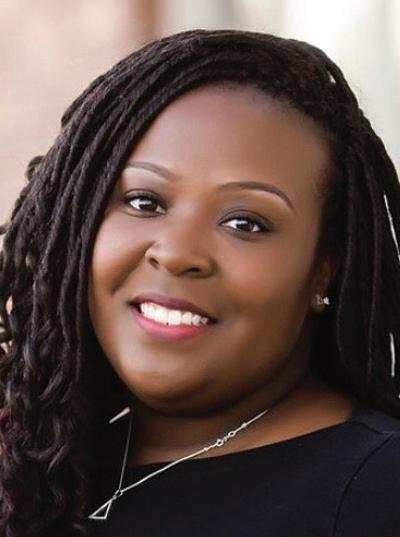
Where do you work?
I am a professional counselor for Counselors Associates.
Where did you go to school? I graduated from Belleville Township High School East. I then earned a Bachelor of Science in Psychology, from Jackson State University, Jackson, Mississippi, a Master of Science in Psychology with a Specialization in Child and Adolescent Development from Capella University (online), and a Master of Arts in Professional Counseling from Lindenwood University, Belleville, Illinois.
What does a professional counselor do? My daily activities include doing assessments (asking questions about the person’s background and why they are coming to counseling), coming up with a plan for treatment (picking a few goals to work towards and planning how we will accomplish them), and one-on-one counseling
Why did you choose this career? When I was growing up, my friends would always come to me when they had a problem or when they just needed to talk. My friends would come to me and vent when they were feeling sad, mad or frustrated. I enjoyed listening and helping them feel better! I’ve also always been interested in how and why people think and act the way they do.
What is your favorite part of the job you have? I enjoy meeting people who feel like they don’t have anyone else to talk to. Helping people feel better; giving them hope when they can’t seem to find it on their own!
Learning Standards: HPE6, NH3

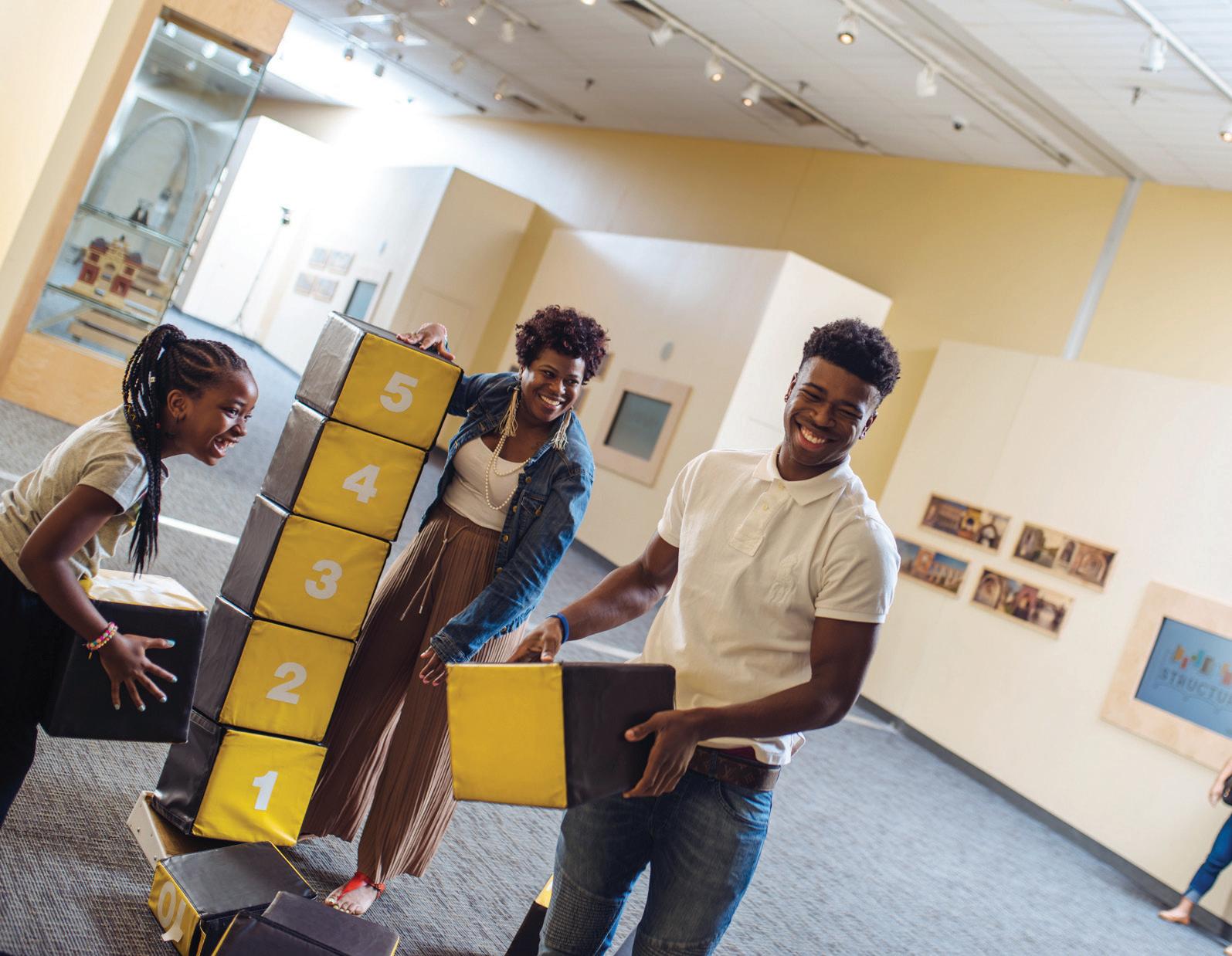
While we are closed temporarily to help curtail the spread of COVID-19, the Saint Louis Science Center is working hard to update our online content to keep you connected to science, learning and fun. Please visit us at slsc.org or follow us on social media to connect with your Science Center.
We appreciate the understanding of the community and look forward to welcoming everyone back to the Science Center soon.


The St. Louis American’s award winning NIE program provides newspapers and resources to more than 8,000 teachers and students each week throughout the school year, at no charge.
Questions or comments? Contact Cathy Sewell csewell@stlamerican.com or 314-289-5422

Russell Elementary School 5th grade teacher Georgen Collier helps students Raymere Jackson, Claire Jones, Ma’Kenzie Gilbert, Miracle Harris,


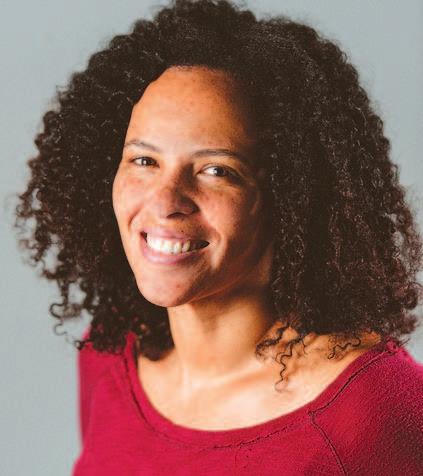

Everyone has had an accident—a fall, a bike wreck, etc. There may be times you get hurt and your parents are not with you, so you need to be prepared. For just a few dollars, you can create a kit that you can take with you to be sure you have everything you need.
Start with a small bag. You may have one at home. If not, you can get durable bags at the dollar store. Important things to add: Neosporin to treat wounds, eye droppers can be used not only to get debris from your eyes, but also to flush debris out of a wound. Tweezers are effective in removing splinters or dirt from a wound. A safety pin can be used in different ways and Band-aids are a must have.

In this experiment, you will make your own quicksand.
Materials Needed:
• 1 Cup of Maize Corn Flour • Half a Cup of Water • A Large Plastic Container • A Spoon Process:
q Mix the corn flour and water in the container.
w To demonstrate the quicksand properties to others, stir slowly, and allow the quicksand to drip from the spoon.

In this project, you will work in groups of 3-5 to solve the problems.
You and your group are stranded on an island, therefore, you have a limit to your food supply. The following list of food items represents all of the raw food and water you have for the next 30 days.
Food Supplies
7.5 liters of rice
7.5 liters of pasta
7.5 liters of beans 15 liters of mixed seeds
100 liters of bottled water
QUESTIONS
It’s always important that you keep your cell phone charged if you have one. This will allow you to keep in contact with your parents and emergency officials. Bottled water is also important to keep on hand. To learn more about first aid kits, check out the links below.
The following website gives tips for a first aid kit for home or the car: http:// kidshealth.org/en/parents/firstaidkit.html.
For more information, visit: https://www.ready.gov/kit.
Learning Standards: I can read nonfiction text for main idea and supporting details. I can make text-to-text and text-to-self connections.
e What happens when you stir the mix quickly?
Analyze: When you stir quickly, there is less water between the grains of flour and the mixture becomes thick and hardens. When you stir slowly, it allows water to move between the grains of flour and the mixture is more fluid and moves more slowly.
Learning Standards: I can follow sequential directions to complete an experiment. I can analyze results and draw conclusions.
each person be issued a day?
Water is needed to cook most of the raw food in your list. The following information will provide you with the food-water ratio you will need to cook your food:
Food-Water Ratio Chart
(1 cup = 250 ml)
Rice: ( 1 : 2 ratio )
Pasta ( 1 : 2 ratio ) Beans ( 1 : 3 ratio )
QUESTIONS
z How much water will be needed to cook each raw food item?
Dr. Raychelle Burks refers to herself as a magical unicorn because women like her are rare. She is an AfricanAmerican female with a doctorate degree in analytical chemistry. She is very popular in social media circles with a blog (called thirtyseven), YouTube videos, and Twitter @DrRubidium. Her initials, Rb, are the same as rubidium, the 37th element on the periodic table. She uses this connection in her blog title and Twitter handle. Burks’ passion is the chemistry of pop culture, specifically zombies, crime shows, and Game of Thrones. Her interests are more than her hobbies, they are scientifically based. Burks earned her bachelor’s degree in chemistry from Northern Iowa University in 2001. Seven years later, she earned her master’s degree in Forensic Science from Nebraska Wesleyan University. Burks earned her PhD in Analytical Chemistry from the University of Nebraska in 2011. She completed post-doctoral research at the University of Nebraska’s Department of Chemistry. In May 2016, she joined St. Edward’s University in Austin, Texas, as an assistant professor. She also assists law enforcement officers to detect explosives.
Burks is often seen at Geek Girl Con; she started the DIYscizone there. She is the co-founder of National Science and Technology News Service, which connects AfricanAmerican STEM professionals with journalists. Burks is a member of the Curly Hair Mafia, an informal group of African Americans who review horror, sci-fi, and fantasy TV shows and movies. She created an idea for a zombie repellent cologne, which caught the attention of several news outlets. Her idea was featured on Perez Hilton’s website, NBC news Weird Science, and Saturday Night Live. Burks is an excellent example of combining your interests and passions with STEM.

To see some of Burks’ sites, visit: http:// thirtyseven. scientopia.org/, https://twitter. com/DIYscizone. Learning Standards:
I can read about an African American who has contributed to the fields Science, Technology, Engineering, and Mathematics.

Enjoy these activities that help you get to know your St. Louis American newspaper.

z What will the daily ration of food and water be for your group?
x If one cup of food/water is equal to two hundred fifty milliliters (250 ml), how many cups of food and water will
DID YOU KNOW?

Social media has changed the way people interact and learn. Listed at the right are Twitter accounts, YouTube, and TED talk links to further your STEM knowledge.
x If your group cooked one cup of all three raw food items once a day, how much water would be needed and much water would be left from your daily water supply?
Learning Standards: I can add, subtract, multiply and divide to solve a problem.
Activities — Facts: Find three news articles about facts you have studied in school this year. Underline facts you studied in class and underline new facts.
Restaurants struggle to survive the Pandemic.
@SciGirls: This Twitter feed is from the PBS show, designed to get more women involved in STEM activities. Stores
@ProjectStepUP: This Twitter feed is designed to help underrepresented populations in STEM.
In this YouTube video, Mae Jemison talks about minorities in STEM: https://www. youtube.com/watch?v=rWLn79cS-cw.
In this TED talk video, they discuss diversity in STEM: https://www.youtube.com/ watch?v=-v8aDo4dV3Q.
Weathercanbe unpredictable.
Acrostic Poem: Choose a news article to read. Select one word from the headline and use that word to create an acrostic poem about the article you read.
Learning Standards: I can use the newspaper to select information. I can make textto-self connections.
Yinka Faleti is only Democrat to file to run against Ashcroft for secretary of state
The August 4 primary election for Missouri secretary of state won’t be very eventful, with only one candidate each filing in the Republican, Democrat, Libertarian, Green and Constitution parties. The Republican candidate is the incumbent, John R. (Jay) Ashcroft. Running as a firsttime candidate (albeit with heady name recognition via his namesake father), he beat Democratic nominee Robin Smith by more than a halfmillion votes (58 to 38 percent) in 2016.
Ashcroft’s Democratic opponent in the November 3 general election will be Yinka Faleti. Faleti is a graduate of the U.S. Military Academy at West Point, a U.S. Army veteran, a graduate of Washington University in St. Louis School of Law, and a former state prosecutor and nonprofit executive. He lives in St. Louis with his wife, Ronke Faleti, and their four children. As of their most recent campaign filings, Faleti had about $70,000 cash on hand while Ashcroft had about $293,000.
The St. Louis American interviewed Faleti about his candidacy.
The St. Louis American: Missouri has never elected a black person to statewide office. Why can you in this position now when no one else could win in any position ever before?
Yinka Faleti: Since statehood in 1821, no person of color has been elected to a statewide office in Missouri. This election for this office is different. The threat to the black vote in Missouri is an existential one. The Missouri NAACP under Nimrod Chapel
Jr.’s leadership has been sounding the alarm. And Wisconsin was a warning. Milwaukee is 40% black, and we witnessed the Republican Party there move to deliberately craft conditions calibrated to suppress the vote as much as possible in that city. Don’t think for a moment that Jay Ashcroft and the Republicans are not now contriving how to do the same in the St. Louis region, in the Kansas City region and across this state.
All throughout Missouri, people who love democracy and recognize this threat and the opportunity for change and leadership by our campaign are ready to elect the first African American to statewide office. We see and feel that readiness and energy in our interactions with voters every day.
The St. Louis American: John Ashcroft is a big name in Missouri. Yinka Faleti, not so much. How do you make up what must be a double-digit deficit in name ID?

with them.
However, we also believe Ashcroft’s name may be an albatross for his campaign. It’s no secret that he and Kris Kobach are running neck and neck as to who’s a bigger voter suppressor. Jay Ashcroft’s name is synonymous with “undemocratic.” We believe Missourians of all political persuasions believe in American democracy and understand that voting is the critical cornerstone of our democracy.
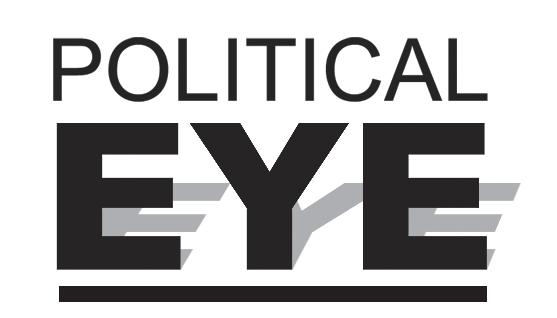
Yinka Faleti: We continue to work hard and meet voters where they are. When we launched this campaign in October, we made plans to connect with voters in every corner of Missouri. And we’d been doing that prior to the coronavirus. However, we’ve had to adapt our strategy because of the pandemic. We’ve shifted our campaign to heavy on digital, phone and all platforms virtual. On March 30, we hosted a virtual town hall on Facebook that reached thousands of voters from around the state. Now, our mantra is if they have internet or a phone, we can connect
The St. Louis American: Let me play devil’s advocate on the democracy bromides. Trump’s base support scarcely wavered despite credible evidence he colluded with a hostile foreign power to win the election. The Republican Party arguably is choosing the suppression of minority enfranchisement and, with it, democracy over losing white power in a majority-minority democracy. What makes you so sure a majority of Missourians wouldn’t take that deal right along with Ashcroft, Kobach and Trump?
Yinka Faleti: That’s why we have elections. We can’t guarantee the outcome. The coronavirus pandemic has revealed so much about our society. Among what’s been revealed is that Missourians are

looking for good, competent leaders of character in their elected state government officials. Many Missourians have been unhappy with the response of the secretary of state and governor to this pandemic. The people of Missouri are ready for change and competent leadership. We can provide that change and leadership they’re looking for.
The St. Louis American: The pandemic is the 300-pound elephant (or donkey) in the room. Win or lose, you make history by campaigning under these bizarre conditions. They have to benefit the incumbent in a down-ballot race. How do you make the socially distant campaign work for you?
Yinka Faleti: My wife, Ronke, and I continue to pray daily for all Missourians, our country and for people around the globe. This pandemic has affected the lives of so many across our state in so many ways.
I’m not sure this pandemic benefits the incumbent, particularly given his lack of leadership in the midst of this crisis. We’ve embraced the new campaign environment. We leverage digital platforms and all things virtual to reach voters in every corner of the state. Being able to reach voters by social media, email or phone actually gives us a greater opportunity to connect with a
Yinka Faleti visited with John Bowman, president of the St. Louis County NAACP, and others at Marquee Restaurant & Lounge in St. Louis on December 12.
voter who may not have been available to attend an in-person event, but can tune in to our campaign from the comfort of their living room. We don’t know how long this pandemic will require distancing, so we continue to develop new virtual ways to reach voters daily.
The St. Louis American: Our editorial board shares your low opinion of the incumbent as an election official. Other than coming from the party that is not actively repressing the vote in Missouri and all over the country, why would you be better? What do you know about running a statewide election authority?
Yinka Faleti: Missouri needs leadership in the Secretary of State’s Office. Instead of adapting to the pandemic and taking measures necessary to ensure Missourians can vote safely and securely this summer and fall, Ashcroft is burying his head in the sand.
As a West Point graduate and combat arms Army officer, our country tasked me with executing difficult missions under austere conditions with competence and character. I was entrusted with the most precious resource this nation has to offer – her sons and daughters. My job was to execute a mission anywhere on this planet, fight to win our nation’s wars and bring everyone in my charge back home safely. I did
that as a leader of soldiers in the Army both here and in the deserts of Kuwait – both before and in response to September 11. And I’ve continued to lead with competence and character since my time in the Army, serving as a state prosecutor and a leader at United Way and Forward Through Ferguson. What I know about serving as secretary of state are things that can’t be taught: honor, integrity and courage to lead in crisis. Taking on this role has unique significance to me. I earned my United States citizenship and right to vote as a youth. I didn’t have it automatically. So, I hold that right very dear.
I lived my early years in a country, Nigeria, where that right isn’t realized by all – as is, unfortunately, the case in so many countries around the world. I fought as a member of our military to ensure every American can enjoy that right – no matter their political persuasion. When you’ve fought for something, it tends to mean a lot more to you. The right to the safe, secure and accessible vote in Missouri is something I would protect zealously. That’s something our current secretary fails to understand is part of his job description.
The St. Louis American: Ashcroft is calling some of his staff back to the office, though the governor just issued a (belated and weak) statewide Stay at Home order. Is this wise management of admittedly essential workers, or would you proceed differently if in his position?
Yinka Faleti: Ashcroft’s call seems to contradict the Stay at Home order and seems out of step with decisions of other statewide elected officials who have, by and large, facilitated their employees working remotely. During a pandemic, it is wise to rely on guidance of trusted scientists and healthcare professionals at the CDC and with the state. As secretary of state, I would proceed in accordance with guidance from those entities.

Northside Youth And Senior Service Center staff prepare meals to deliver to area seniors. Its clients are primarily African American and live in poor neighborhoods that have seen sharp rises in the number of people testing positive for COVID-19.
‘The
Northside agency now serving nearly 1,000 shut-in seniors
American staff
Northside Youth And Senior Service Center, which typically serves roughly 600 home-bound seniors, is now serving nearly 1,000 seniors due to mandatory Stay at Home orders, increased referrals, and assistance provided to smaller centers, the agency stated.
Its clients are primarily African American and live in poor neighborhoods that have seen sharp rises in the number of people testing positive for COVID-19.
“We have been in constant contact with the Saint Louis Area Agency on Aging (SLAAA) since the Stay at Home orders were first given,” said Lynne Lane, Senior Center director.
“They made it clear that our role would be
By Chris King Of The
n “Most of our seniors live alone and would have trouble accessing a regular meal without our service.”
– Larry King, a home delivered meal driver
to help St. Louis meet the nutrition and health needs of St. Louis seniors during the crisis. The level of need, however, exceeded what we anticipated.”
She Northside is taking every precaution with staff and volunteers to ensure best practices
$27 million that the U.S. Department of Health and Human Services is awarding to 29 health centers in Missouri, Affinia Healthcare will receive $1,709,675; Betty Jean Kerr People’s Health Centers will receive $1,213,925; Family Care Health Centers will receive $981,245;
are followed, as established by the City of St. Louis Department of Health and the U.S. Centers for Disease Control and Prevention. She said staff are practicing social distancing and performing wellness checkups on seniors via telephone.
“Most of our seniors live alone and would have trouble accessing a regular meal without our service,” said Larry King, a home delivered meal driver. “As a small not-for-profit, the increase has strained our financial and physical resources, but the urgency of the need gives us no other choice than to respond.”
For more information, call 314-531-4161, email kking@nsyssc.com or visit https://www. nsyssc.com/.

“Almost all of the COVID19 deaths in the
of St. Louis have been African Americans,” said Angela Clabon, CEO of CareSTL Health. “That alone speaks to the need for testing in North St. Louis where our
Rep. Green:
‘We have an obligation to help our local businesses’
By
State Rep. Alan Green, D-Florissant, wants Gov. Mike Parson to stop overlooking minority-owned businesses in the manufacture and distribution of personal protective equipment (PPE) in the face of the COVID-19 crisis.

n “I have received communications that concerned me about the lack of effort being made by Office of Administration to pursue business opportunities with Minority, Women and Disadvantaged Business Enterprise companies.”
– State Rep. Alan Green wrote to the governor
“I have received communications that concerned me about the lack of effort being made by Office of Administration to pursue business opportunities with Minority, Women and Disadvantaged Business Enterprise companies to source PPE and other vital supply and service needs during the state’s massive COVID19 response,” Green wrote in a letter to Office of Administration Commissioner Sarah Steelman on Thursday, April 9. “We can see from the data that this pandemic is disproportionately impacting AfricanAmerican communities, particularly highly dense pockets of North St. Louis County.” Parson was asked to comment on April 9; his response will be reported if received. Statistics from St. Louis County have identified a higher concentration of COVID-19 cases in North St. Louis County. While black St. Louisans are feeling a disproportionate impact of this disease on their health, Green said that community should not experience a disproportionate impact financially as well.
“As a former director of the State’s office of Equal Opportunity, I know firsthand the challenges these sorts of businesses face,” Green said. “Many businesses are struggling to stay solvent during these difficult times, especially our small businesses. Hardship is already being felt by both business owners and those they employ. The financial implications from a community stability perspective are enormous.”
Of the 9,000 businesses in the North St. Louis County area, Green said that 85 percent are small businesses. He urged Parson to utilize some of the unprecedented spending authority granted to him on April 8 by the Missouri General Assembly –nearly $6 billion – to support working families and minority-owned businesses
“We have an obligation to help our local businesses during this difficult time,” Green urged.
‘Civil rights are non-negotiable’
Nationally, the Lawyers’
By Marc H. Morial National Urban League
“I feel that a large part of my role as publisher of Black Enterprise is to be a catalyst for black economic development in this country. When I can act as an instrument to make it happen for legitimate and reasonable people, I do it,” said Earl G. Graves Sr.
“I try to be helpful and put people together, whether it’s finding a candidate for a trustee position at Howard University or reaching out to the CEO of Motown Records to save a company that was at the fore-
front of black economic development in the early days.”
As the nation’s preeminent civil rights organization dedicated to the economic empowerment of black people, the National Urban League shares a mission with Black Enterprise magazine and its late founder and publisher, Earl G. Graves Sr. Founded in 1970, Black Enterprise has helped to launch and nurture the careers of two generations of African American professionals and innovators. Earl Graves was not just a chronicler of black businesses and entrepreneurs,
but a leader, and a role model for excellence in his own right.
Graves’ partnership with and support of the National Urban League was extensive and influential.
Graves’ devotion to his three sons, Earl Jr., John and Michael, was a large part of the inspiration for the National Urban League’s Male Responsibility Campaign. The initiative, launched in 1985 by then-president John Jacob, was designed to educate young
men about the importance of a father in a child’s life.

The following year, Jacob and Graves teamed up to persuade a national hotel chain, the frequent host of black-themed conventions and meetings, to expand its advertising into black-owned media.
Born in 1935 to West Indies immigrants, Graves was seized by the entrepreneurial spirit early in his life, selling Christmas cards door-to-door in his Brooklyn
neighborhood at the tender age of 6. His father’s struggle to move beyond blue-collar employment, despite a high school diploma, was a motivating force as he pursued a college education. He graduated in 1957 from Morgan State University, whose business school now bears his name.
Graves served two years as an officer in the U.S. Army, then worked in various jobs before joining the presidential campaign of Lyndon Johnson in 1964. The next year he was appointed to the staff of U.S. Senator Robert F. Kennedy, for whom he worked until the sen-
ator’s assassination in 1968. He started Black Enterprise with a $250,000 loan, and turned a profit in a remarkable 10 months.
“Black Enterprise was just a modest magazine when I founded I,” he said. “Just me, a few brave advertisers like Pepsi, ExxonMobil and General Motors; and a small but spirited staff. And one other person who did just about everything there is to do to put out a magazine—my wife, Barbara.”
Marc H. Morial is president and CEO of the National Urban League.
Better Business Bureau
The Better Business Bureau (BBB) advises consumers to use extreme caution when doing business with Alphamential Accessories LLC, which claims to be located in Chesterfield, and Atlantic Medical Supplies, which claims to be located in St. Charles. Both businesses
Continued from B1
population. Advocates for a Healthy Community in Springfield received $1,988,555 of this federal money, or 7.4% of the state’s share.
claim to sell medical supplies, including face masks. BBB’s research found that these companies, with nearly identical websites, are not physically located where the websites claim. According to web domain registry information, each website is less than two months old.
The websites offer a number of medical supplies for sale. Prices on some items appear to
Why the disparity?
“The funding is based upon the 2018 UDS (Uniform Data System) numbers, which is the reporting system used by federally qualified health centers to report, among other factors, the number of uninsured patients we serve,” said Angela Clabon, CEO of CareSTL Health.
be marked down, making the consumer believe they are on sale.
A BBB investigator called Alphamential Accessories LLC and attempted to order some face masks. When the investigator attempted to order a few boxes of face masks, he was told that he had to order in bulk.
The investigator asked if he could come by their location
listed on its website, near Spirit of St. Louis Airport. The Alphamential Accessories LLC employee said that they do not have a store there and were affiliated with a medical supply business at the location.
The owner of the actual medical supply business told BBB any affiliation between his business and Alphamential Accessories LLC “was abso-
“In St. Louis city and county, we have Gateway to Better Health to assist patients who fall between the gap. Our uninsured number was reported lower because we receive funds from Regional Health Commission, which is Gateway to Better Health. Unfortunately, those individuals were not captured as uninsured. Yes, maybe they should have been, but they were not.”

Health center awardees in Missouri may use these funds to help their communities detect coronavirus; prevent, diagnose, and treat COVID19; and maintain or increase health capacity and staffing levels to address this public health emergency. How will the regional health centers use the funds?
“We intend to use those funds to purchase much needed (and hard to get) Personal Protective Equipment (PPE) to ensure that we protect our staff appropriately,” said Dwayne Butler, CEO of Betty Jean Kerr People’s Health Centers.
“Also, we hope to provide some relief to our incredible employees with a return to full, regular pay and any other appropriate financial support. Finally, the support will help us continue to adjust to this rapidly changing operating environment to ensure that we remain available to serve our communities’ health care needs.”
At CareSTL Health, Clabon said, “The funding will be used to continue serving our patients but also to prevent layoffs
Continued from B1 Committee for Civil Rights Under Law is making a similar effort.
On April 7, 2020 a coalition of 56 civil rights and workers’ rights organizations led by the committee sent a letter to the U.S. Department of Labor’s Office of Federal Contract Compliance Programs (OFCCP) to oppose the department’s decision to temporarily
lutely false.” The medical supply business owner told BBB that his business is the only business at that location.
In addition to its website, which was registered on February 29, Alphamential Accessories LLC promotes its products through a Facebook business page.
Atlantic Medical Supplies is using the address of a residence on Muegge Road in St.
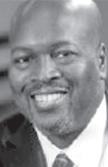
n “We intend to use those funds to purchase much needed (and hard to get) Personal Protective Equipment (PPE) to ensure that we protect our staff.”
– Dwayne Butler, Betty Jean Kerr People’s Health Centers
and retain our employees. We understand, given the pandemic, services are dipping but the funding will help us keep our employees on the payroll.”
One very important service is “dipping” only for want of supplies.
“The biggest issue we are dealing with right now is having enough testing kits to meet the patient demand for testing,” Clabon said on April 8. “Today alone we tested 87 people. We have 87 people
exempt and waive affirmative action obligations under new supply, service, and construction federal contracts for COVID-19 relief.
Charles. The business website was registered on March 16, according to web domain registration. BBB spoke with the resident living at the address being used by the business, and they said they had no affiliation with Atlantic Medical Supplies. Neither company is registered to do business with the Missouri secretary of state.
scheduled for tomorrow. This is in both locations. We are not testing Friday-Good Friday because we do not have enough testing kits. Realistically, given the volume of calls we are receiving we could probably test 100 people a day.” Clabon said that the influx of federal funds will help keep the doors open, but they need test kits for the people who walk in those doors.
“We are not going to slow down our testing because it is needed,” Clabon said. “I am very upset that almost all of the COVID-19 deaths in the city of St. Louis have been African Americans. That alone speaks to the need for testing in North St. Louis where our health centers are located. Our community has to be tested and we need testing kits now!” For CareSTL Health, call 314-367-5820 or visit https://carestlhealth.org/. For Betty Jean Kerr People’s Health Centers, call 314367-7848 or visit https:// phcenters.org/. To locate the health center closest to you, visit FindAHealthCenter.HRSA. Gov
The letter highlights that the pandemic and its economic repercussions are disproportionately impacting people of color and other historically marginalized communities and urges the federal government to do everything to ensure that federal contractors responding to COVID-19 are affirmatively recruiting and promoting all employment opportunities to those most impacted.

The letter also outlines the critical obligations under Executive Order 11246 and federal statutes that have been waived. These laws require government contractors to undertake affirmative efforts to ensure that equal opportunity is provided in all aspects of employment, including recruitment and hiring. The exemptions not only apply to federal contractors, but also to the subcontractors with whom they do business. The waivers will undoubtedly discourage covered employers responding to the coronavirus pandemic from casting a wide net to recruit diverse workers from historically underrepresented populations. They will also keep contractor and subcontractor workers and their union representatives in the dark about their legal rights and make enforcement of affirmative action regulations even more difficult.
“Communities of color and other marginalized communities are disproportionately feeling the economic shocks of this pandemic,” said Dariely Rodriguez, director of the Economic Justice Project at the committee. “Civil rights are non-negotiable and we must do everything to ensure that limited employment opportunities are being targeted at those who need them the most.”
APRIL 16 – 22, 2020
With Alvin A. Reid
Your love give me such a thrill, But your love don’t pay my bills,
I need money - A lyric from Barrett Strong’s, “Money”
The St. Louis Battehawks were the sensation of the shortlived XFL.
They had the most fans. They had the most fans watching their games in their home market.
They sold the most team related merchandise.
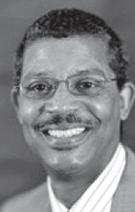
On Monday, the St. Louis Convention and Visitor’s Commission learned that the XFL owed it more money than any other creditor it now seeks to dodge through its announcement of bankruptcy.
The stunning move came the first business day after the XFL was releasing most of its employees and word leaked out that there would be no 2021 season.
Five games - half a season - were in the record book when the league went on hiatus because of the spreading COVID-19 virus in late March.
Like so many Americans, the XFL learned that a few missed paychecks could lead directly to insolvency. There was no desperate “Hail Mary” from XFL owner Vince McMahon and his Alpha Entertainment.
He punted.
“Unfortunately, as a new enterprise, we were not insulated from the harsh economic impacts and uncertainties caused by the COVID-19 crisis. Accordingly, we have filed a voluntary petition for relief under Chapter 11 of the U.S. Bankruptcy Code,” the league announced in a written statement.
“This is a heartbreaking time for many, including our passionate fans, players and staff, and we are thankful to them, our television partners, and the many Americans who
rallied to the XFL for the love of football.” McMahon must be so
“heartbroken” that he had not spoken publicly about the demise of his beloved XFL 2.0 as of Tuesday. His first version crashed and burned after a single season without a pandemic to blame.
Here’s what he could be saying.
“Sorry, St. Louis CVC. I stiffed you for $1.6 million and threw salt on the festering wound of the NFL dumping you. But hey, I owe anywhere from $10 to $50 million for this debacle. You’re in line with a lot of other suckers.”
“Sorry, Jonathan Hayes, Battlehawks head coach and GM. I stiffed you for $633,333. You worked your behind off to field an exciting, winning team that captured the imagination of thousands of Battlehawks fans. You deserved better. But, look on the bright side. I owe Dallas Renegades coach Bob Stoops $1.08 million and Tampa Bay Vipers coach Marc Trestman $777,777. It could be worse for you.”
“Sorry, Battlehawks fans. You can enjoy those shirts, hats and jackets you bought forever. If you purchased a season ticket or tickets for one of the three home games not played, you’ll get a refund. It’s the best I can do.”
According to bankruptcy documents, the XFL’s five other head coaches are each owed $533,833. Ticketmaster is left holding the bag for $655,148 and MetLife Stadium is out of $368,000 And so much for the McMahon promise that his successful WWE had nothing to do with the XFL. Through the bankruptcy filing, it has been learned that WWE owned 23.5 percent of the Class B stock in the XFL and McMahon owned 76.5 percent. McMahon also owned 100 percent of the XFL’s Class A stock, which usually comes with more voting control than Class B. No question McMahon faces the largest personal loss - depending on the bankruptcy settlement. But it’s now a fact

have found a
that he stood at a podium and lied about his “partners” and no business ties between the XFL and WWE. It seems to work for his friend the POTUS, but this fib blew up in his bankrupt league’s face.
As I’ve written several times, the XFL hopefully taught the NFL a lesson in diversity. It did not shy away from hiring black head coaches, general managers and team presidents. The XFL owned the teams, thus hiring in key positions did not have to be approved by an owner who feared the ridiculous “what ifs” when it comes to minority hiring in professional sports.
Applause should go to former Commissioner Oliver Luck, not McMahon. In fact, the XFL could reportedly be sold following the bankruptcy settlement and maybe Luck will be a major partner in that effort - if it actually happens.
The “kaw-kaws” are now silent. McMahon and the XFL flew the coop, leaving a staggering debt in St. Louis behind
and another Strong lyric from “Money.”
Money don’t get everything it’s true
But it won’t get I can’t use I need money Cards worth big-time cash
The St. Louis Cardinals are worth an estimated $2.2 billion, seventh in Major League Baseball, according to FORBES.
The New York Yankees top Major League Baseball’s franchises with a value of $5 billion, the Los Angeles Dodgers are worth 3.4 billion and the Boston Red Sox are third at $3.3 billion.
Next are the Chicago Cubs ($3.2 billion), San Francisco ($3.1 billion), the New York Mets ($2.4 billion), St. Louis and Philadelphia ($2 billion).
The Miami Marlins, whose principle owner Derek Jeter has traded away most of its best players to cut payroll, are
MLB’s least valued franchise at $980 million The team was valued at $1 billion last year. The other bottom feeders are Kansas City ($1.025 billion), Tampa Bay ($1.05 billion), Cincinnati ($1.075 billion) and Oakland ($1.1 billion).
Racing to get fired
Kyle Larson, who is part Japanese, let the N-word fly during a NASCAR I-Race last weekend when his communication equipment faltered. It led to his firing by Chip Ganassi Racing. We’re not talking just the live-streamed virtual I-Racing events, Larson has lost his ride when, and if, actual racing returns this year.
Almost all of Larson’’s sponsors jettisoned him after the incident and Ganassi Racing was forced to dump their up-and-coming driver.
“After much consideration, Chip Ganassi Racing has determined that it will end its relationship with driver Kyle Larson,” Ganassi said.
“The comments that Kyle made were both offensive and unacceptable, especially given the values of our organization. (I)t became obvious that this was the only appropriate course of action to take.”
Larson was in the final year of his contract with Ganassi and, based on his performance over the past season and four races in 2020, he was going to be a highly sought-after free agent who would command at least $10 million for his services - not including his endorsement contracts.
It’s difficult to believe a man whose grandparents were held in a Japanese internment camp during World War II would be throwing around racial epithets, but it happened.
“I wasn’t raised that way. You know, it’s just an awful thing to say,” Larson said in a video apology released Monday, the day before he was canned.
“I feel very sorry for my family, my friends, my partners, the NASCAR community, and especially the AfricanAmerican community. I under-
stand the damage is probably unrepairable.”
You got that right, Mr. Larson.
The Reid Roundup
Jordan Ta’amu, former Battlehawks quarterback, has to be thanking his lucky stars to now be a member of the world champion Kansas City Chiefs... KMOX radio personality Charlie Brennan was a college classmate of former XFL Commissioner Oliver Luck at Boston College. If the XFL, or a league under another title, comes back for a third try and Luck is involved, maybe Brennan can convince him to put the league offices in St. Louis - home of the crazed and disappointed Battlehawks fans... Adding insult to injury, just as XFL owner Vince McMahon was crying poverty and filing for bankruptcy, the state of Florida ruled that his WWE is an “essential business,’ and live, televised wrestling cards began hitting the airwaves this week... Will St. Louis football fans now hate McMahon as much as NFL Commissioner Roger Goodell and L.A. Rams owner Stan Kroenke?... Hopefully, former Battlehawks coach Jonathan Hayes will get the money he’’s owed by the XFL and get another shot coaching in the NFL... Former NFL quarterback Tavaris Jackson was killed in a one-car accident last Sunday near his hometown of Montgomery, Alabama. He was quarterbacks coach at Tennessee State last season after a 10-year NFL career with the Seattle Seahawks, Minnesota Vikings and Buffalo Bills. Alvin A. Reid was honored as the 2017 “Best Sports Columnist – Weeklies” in the Missouri Press Association’s Better Newspaper Contest and is a New York Times contributor. He is a panelist on the Nine Network program, Donnybrook, a weekly contributor to “The Charlie Tuna Show” on KFNS and appears monthly on “The Dave Glover Show” on 97.1 Talk.” Find him on Twitter at @aareid1.
By Earl Austin Jr.
Of the St. Louis American

Earl Austin Jr.
The members of the 2020 St. Louis American Girls “Fab Five” All-Star Team represent outstanding leadership at the point guard position and inside dominance in the low post. The three point guards on the first team are seniors Que Love of Edwardsville, Jordan Peete of Ladue and sophomore Saniah Tyler of Incarnate Word. The two forwards who patrol the inside for this team are seniors Jakayla Kirk of Hazelwood Central and Jasmine Manuel of Rockwood Summit.
Here is a look at the first team members of the St. Louis American “Fab Five” Girls All-Star Team.
Jakayla Kirk (Hazelwood Central): The senior power
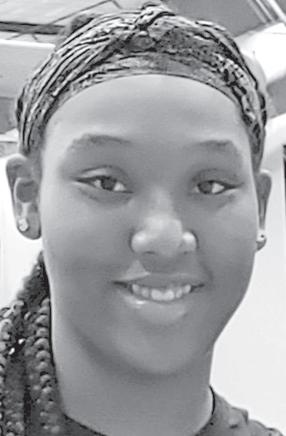
forward led the Hawks to a Final Four berth in the Class 5 state tournament. She is a strong low-post player who could also dominate on the boards. Kirk averaged 18.9 points, 9.0 rebounds and 2.1 steals in leading the Hawks to a 20-9 record.
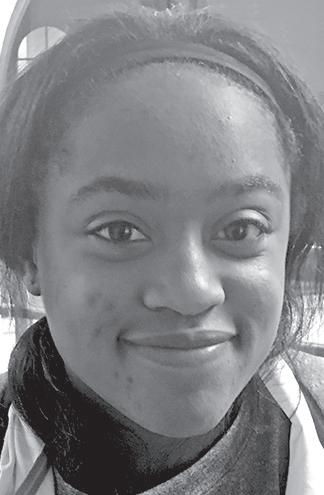
Que Love (Edwardsville): An outstanding senior point guard who was the floor leader and catalyst for the Tigers, who won the Southwestern Conference championship and a regional title. Love averaged 11.4 points, 2.4 rebounds, 3.5 assists and 2.5 steals while running the show and playing stellar defense.
Jasmine Manuel (Summit): The 6’3” senior was a dom-

inant force in the paint in leading the Falcons to a berth in the Class 4 state quarterfinals. Manuel averaged 17.1 points and 12.6 rebounds to lead Summit to a 26-4 record. She scored 28 points in a district championship victory over Westminster Christian. Manuel finished her career as the school’s leader in scoring and rebounding. She has signed with Tuskegee.

Jordan Peete (Ladue): An excellent senior point guard who led the Rams to one of their best seasons in many years. She was excellent at both ends of the court as she averaged 16 points, 3.5 rebounds, 5.3 assists and 3.4 steals in leading Ladue to a 23-5 record and a
berth in the Class 4 state quarterfinals. She has committed to Lipscomb University.

Saniah Tyler (Incarnate Word): The sophomore standout is the latest in the long line of tremendous point guards at Incarnate Word. She excelled at both ends of the court and could take over games in clutch situations with her scoring and passing.
Tyler averaged 11.8 points, 4.2 assists and 2.6 steals in leading the Red Knights to a 27-4 record and yet another Final Four berth in the Class 4 state tournament.
St. Louis American “Fab Five” Girls All-Star Teams
First Team Jakayla Kirk 5’10” Hazelwood Central (Sr.) Que Love 5’4” Edwardsville (Sr.)
Jasmine Manuel 6’3”
Summit (Sr.)
Jordan Peete 5’6” Ladue (Sr.)
Saniah Tyler 5’7” Incarnate Word (Soph)
Second Team
Faith Bland 5’10” Metro (Sr.)
Kelsey Blakemore 5’9” Whitfield (Jr.)
Jayla Kelly 6’3” Parkway Central (Sr.)
Kennedi Watkins 5’11” Marquette (Jr.)
Aliyah Williams 5’4”
Parkway North (Jr.)
Third Team Mia Collins 5’10” Ladue (Sr)
Kayla Gordon 5’5” O’Fallon
‘An
outbreak within these levels of
confinement can produce a tragic outcome’
American staff
EXPO organizer Charlie Gentry remembers sanitation not being on the list of “things to do right” when he was incarcerated. He is rightly horrified now hearing about COVID-19 being found in prisons around the country and now in St. Joseph, Missouri.
EXPO is a newly formed organization spun off by Metropolitan Congregations United (MCU). EXPO is an acronym for EX-incarcerated People Organizing.
“Guards come and go,” Gentry said. “They could have been exposed. Newly incarcerated persons may have been exposed. Our prisons and jails have the potential of being nothing but kill boxes.” Gentry is referring to the reality of prison. Personal care items, like soap, must be purchased by inmates. Visits to a nurse require a co-pay. No information is readily available as to how often cells and public areas are disinfected.
EXPO leader Traci Stanton speaks directly to the necessity of these releases.
“It is imperative that during this sensitive time that we protect all individuals as best as possible,” Stanton said. “This pandemic has had a profound and drastic effect on our community and could create the same or much worse effect amongst the prison population. An outbreak within these levels of confinement can produce a tragic outcome. It is necessary that we consider measures to ensure the safety of the individuals that are incarcerated hence a mandatory release or an expeditious evacuation.”
The words of Jake Hubbard, another EXPO leader, express his belief in the
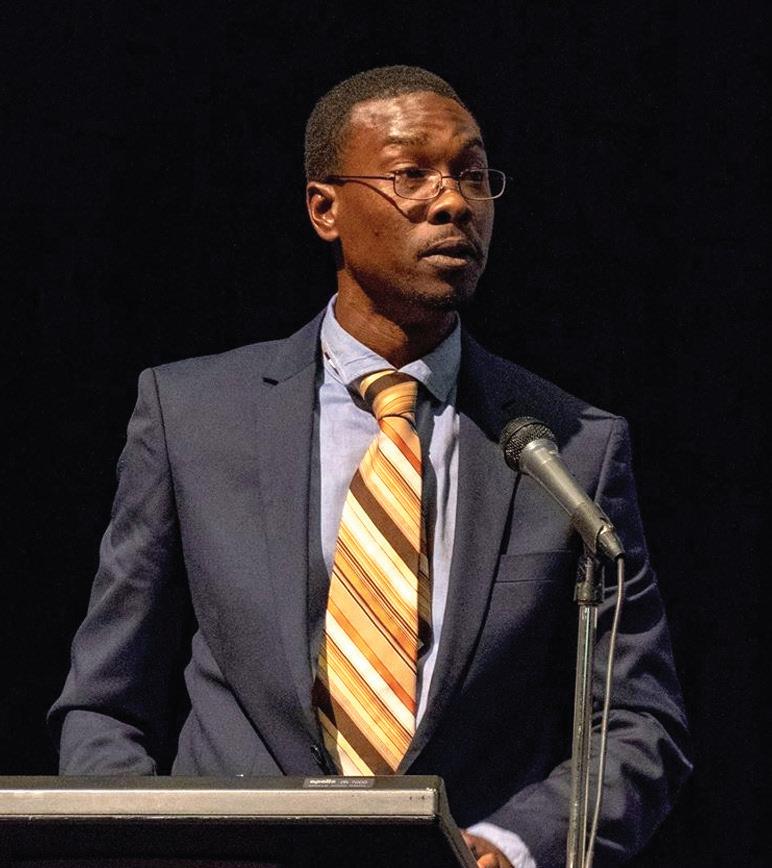
system’s suppressive malfunctions.
“As we are experiencing, this outbreak has highlighted some glaring weaknesses in our society,” Hubbard said. “There is a lack of sanitation, nourishment and hydration in our prisons. I believe many fathers and mothers will be sentenced to death, because basic human rights have not been met in the State of Missouri and federal correctional facilities.”
The voices of these formerly incarcerated people emerge from the dungeon of their own experiences. That the potential explosion of COVID-19 among those incarcerated in the state of Missouri seem to be substitutionary sacrifices for a system in need of redemption is reprehensible, EXPO stated – action must be taken immediately to stop the willful procession of incarcerated humans as lambs
to the slaughter.
“Our prisons and jails have the potential of being nothing but kill boxes,” said EXPO organizer Charlie Gentry.
Metropolitan Congregations United (MCU) and EXPO are part of the Gamaliel Network, faith-based community organizations in 16 states, all calling for release from prison and jail of persons over the age of 65, those non-violent inmates with already compromised health conditions, and especially those simply waiting for court because they are too poor to pay a bail or bond. EXPO works to end mass incarceration, eliminate all forms of structural discrimination against formerly incarcerated people, and restore formerly incarcerated people to full participation in the life of our communities.
For more information on MCU and EXPO, contact susan@mcustl.com or wtaftexpostl@gmail.com.

The Message
I remember working with a young man who had been incarcerated for a good part of his rather young life and he, by his testimony, got a lot closer to God during this season of his life. He said prison is indeed the devil’s playground if there ever was one. Due to his attempt to walk with God, he claimed to be under constant attack.
I’ve heard many a minister say there is one sure way to get Satan’s attention and that is to turn your life over to Christ. Your lifestyle is what gives Lucifer access to your world. As long as you engage in the negative side of life, he doesn’t need to spend any time struggling for your soul.
Succumbing to life’s trials and temptations is sentence enough to ensure that you will die and live void of God’s presence.
anchored in faith, lived with integrity means Satan has his work cut out for him. That makes you a target for attack, as my incarcerated friend described, but it also guarantees your victory. The reality is Satan is coming for anyone who tries to hear and respond to God’s Word. It’s his job. “Some people are like seed along the path where the Word is sown. As soon as they hear it, Satan comes and takes away the Word that was sown in them.” Mark 4:5.

Dealing with all we have to deal with in the physical world makes it easy to sometime lose sight of the obvious. A life without purpose, one without direction or faith, is a life wandering aimlessly on a highway headed straight to hell. The devil does not have to expend any energy trying to gain access to this kind of a life. He can merely set up a toll booth at hell’s entrance and collect unsuspecting souls on the way by.
Many of us can’t even remember the night before. We just try and deal with the headache and consequences of the morning after. Perhaps we should at least try to make the devil sweat just a little bit. A life dedicated to purpose,
If we know this, what are we doing to arm ourselves against his assault? Satan is liar. He’s good at what he does. “And no wonder, for Satan himself masquerades as an angel of light.” 2 Corinthians 11:14. As a believer, you have a neon sign that shines brightly in all kingdoms of this world and the next. It alerts everyone around you about your life’s purpose to honor God with how you live. Satan has a problem with any life so filled with the love of God that it can’t wreck with the temptations of this world. I’m told that he once loved God profusely. But he came to love himself even more. And he wants you to come to love yourself more than you love God.
“For, as I have often told you before, and now say again even with tears, many live as enemies of the cross of Christ. Their destiny is destruction, their god is their stomach and their glory is their shame.” Philippians 3:18-20.



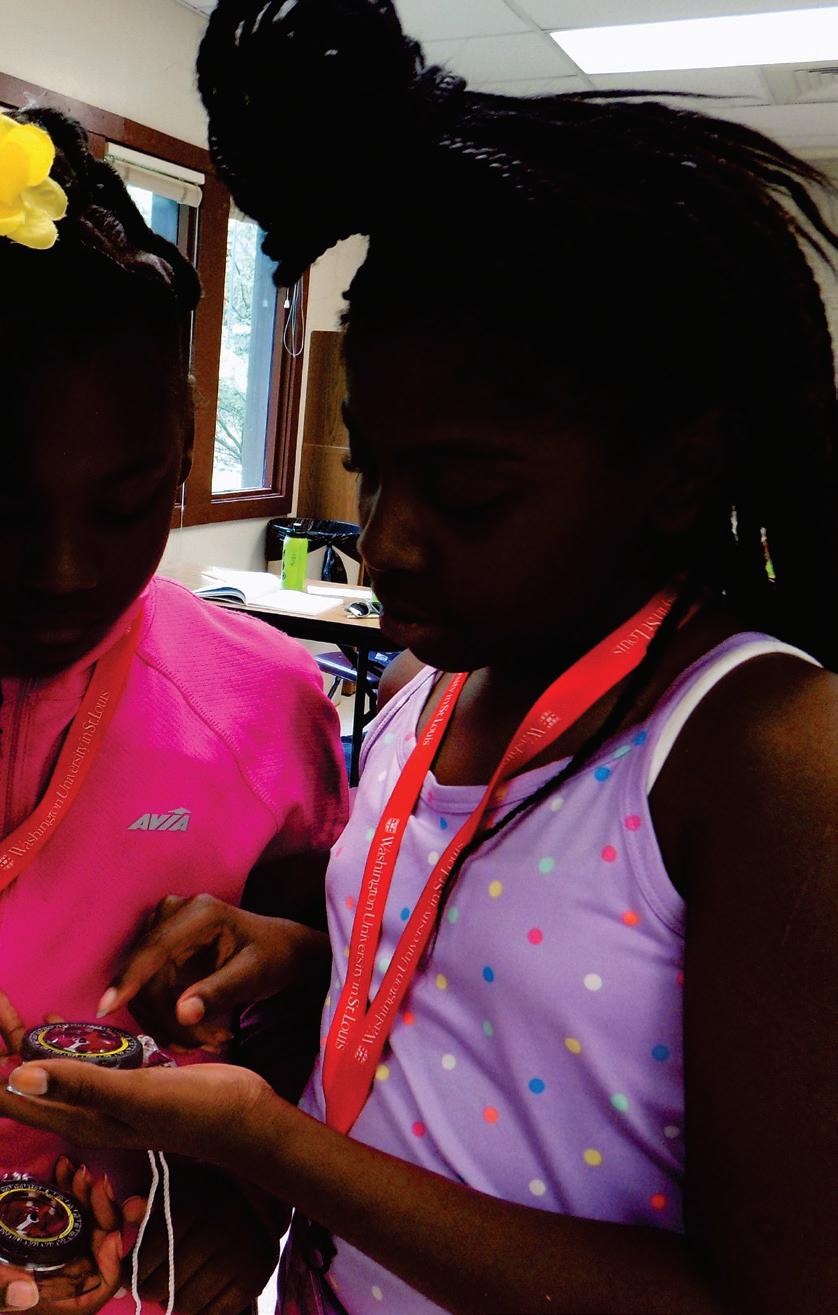




TheSt.Louis American's SummerScience Academywas heldat LittleCreek Nature areathis pastJune. Twentyfive exceptional young scientists attendedtwofull weeksofintensive science lessons, research,hands-on experimentsand guest speakers. Thisweekly series will recognize these aspiring scientists!
“I love the facts you learn at camp and it is not boring. The people are very welcoming. At camp we learned all different types of science. My favorite activity was building the robot.”
-Chaz W.


By Kenya Vaughn
Of The St. Louis American
St. Louis lost a piece of living music history with the passing of “Big” George Brock on Friday, April 10, a month before his 88th birthday. Brock, a singer and blues harp player, has been a staple of the scene longer than some grandparents have been alive. He made his way to St. Louis from Mississippi just as the Great Migration began to crest.
In the 70 years he called St. Louis home, Brock played a critical role in keeping the rich legacy of the blues alive – and maintaining the integrity of the strong connection between blues music and the city. He was born into a family of sharecroppers in Grenada, Mississippi on May 16, 1932. Brock’s life reads like the lyrics of a blues classic.
“They [plantation owners] would come out and measure your food out and it had to last the whole month,” Brock said during “Music Moved the Movement: Civil Rights and the Blues,” a televised program. “And you had to make it last. If you didn’t, you had to go out and hustle for yourself, because you didn’t get nothing else.” Brock said plantation owners monitored every aspect of life for the families who toiled the land.
See Brock, C2

By Kenya Vaughn
Of The St. Louis American
Tayarisha Poe grew up totally enamored with “The Godfather.”
“My parents loved that movie and my mother would do my hair while we watched ‘The Godfather’ trilogy,” Poe said. “So, it’s written into my DNA.”
The film franchise made her fall in love with stories of people behaving badly and explaining it away somehow.
Poe noticed a common denominator among these types of films – they typically starred older white men. So, she started writing “Selah and the Spades” back in 2014 to fill a void.
“I also wanted to know what it looked like to see myself – or someone who looked like me – wrestling with these questions of morality,” Poe said. “People love to see black women apologize or be punished. I don’t get what weird sadism it is, but I’m not down with it. I just wanted to see someone who looked like me being able to mess up and be guilty and be selfish and be loud and take up space – and not be sorry.”
The film, Poe’s feature debut, was a standout
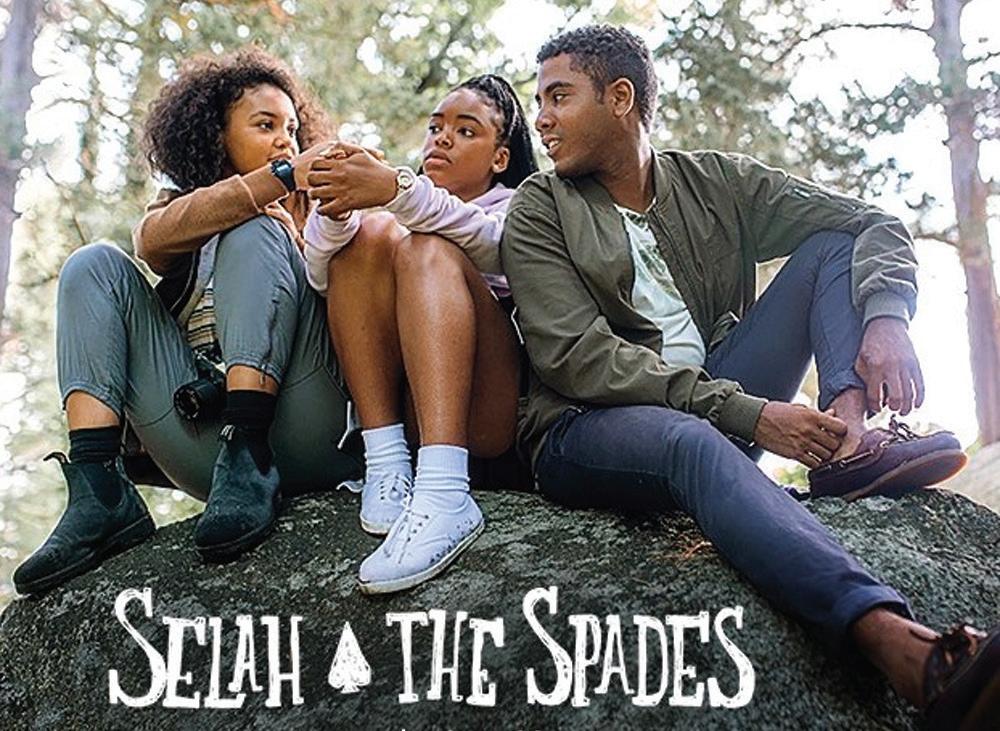
of the Sundance Film Festival when it premiered as a NEXT selection – and was scooped up by Amazon last summer. It debuts on Amazon Prime Video this Friday (April 17).
The film stars Lovie Simone as Selah – a no-nonsense high-school senior looking for a protégé to take over the faction she helms at an elite boarding school. Just as in a deck of cards, the spades are the most powerful suit. And
Selah keeps them as the most revered – and feared – group by any means necessary.
The film also stars Jesse Williams, Celeste O’Connor, Gina Torres, Henry Hunter Hall, Evan Roe, and Jharrel Jerome. Given her own experience attending a board-

By Kenya Vaughn Of The St. Louis American
The nightlife scene is a ghost town as we sit and wait for the coronavirus curve to flatten. Partying from home via social networks, ZOOM brunches and Google Hangout happy hours have become the new normal as an escape from the social distancing. What does that mean for those who rely on clubs and concerts as their primary source of income?
“I woke up and it was like somebody pressed a big red button to stop everything,” said Vanessa Townsend. Through her Vanessa Townsend LLC, she manages logistics for events and concerts. She also works in management at Prime 55 restaurant. “Everybody I work with was in the planning stages for an action-packed spring. All of that came to a sudden halt. It was overwhelming at first that all my business stopped.”
Townsend, DJ James Biko and Ready Room security staff Ronald “B” Jones are all looking at the bright side – albeit with a dose of their new reality.
n Vanessa Townsend, DJ James Biko and Ready Room security staff Ronald “B” Jones are all looking at the bright side – albeit with a dose of their new reality.
After more than four years as a member of the security staff of The Ready Room, Jones has been spending his weekends at home. He didn’t know the indie rock band The Wonder Years’ Friday, March 13 show would be the last in the foreseeable future for him and his “work family.”
He loves his job, the people he works with and the broad range of people he gets to interact with at The Ready Room – which hosts shows from hip-hop, rock to reggae.
Some of the best shows he’s ever seen have been while working there.
“The artists who play, the people who come to see them there and the people I work with are great,” Jones said. “It just made for a special kind of energy.”
Like so many on the nightlife scene, he’s waiting to see how things shake out.
“Everybody in our line of work is taking a big hit, from all sides,” Jones said.
He now relies on sales from his Sacred Symbols jewelry line as his sole source of income.
“I can’t complain though. I live a simple life,” Jones said.
He is using the downtime for creative expression and to go inward spiritually – and suggests that others do the same.
Townsend is on the same wavelength.
“If you are a person whose whole business is entertainment, it could make you go into panic mode,” she said. “Prayer has really got me through and being connected with optimistic people” has carried her through. “I haven’t been able to talk
See Nightlife, C2

“The hard part about it is when they (white people who oversaw the plantations) accused you of being out of order,” Brock said, pausing with emotion before telling the story of how a family member was lynched because he refused the advances of a white woman.
“She said you might as well, because if you don’t, I’ll say you did and get you killed anyway,” Brock said.
She kept her word. His entire family was forced to gaze upon the body as it was dragged behind a black truck.
“They told us, ‘This is what happens when you try to mess with a white woman,” Brock said. “It was terrible bad. I’m only telling you what I know and what I saw.”
One day Brock was sitting in school and “the boss man” came and pulled him out. He took Brock home to his parents.
“The boss told my daddy I was too big to be sitting up in somebody’s schoolhouse,” Brock said. “He said I needed to be out working in the fields.”
That moment marked the end of his formal education. Brock was 8 years old. It was around this time that Brock’s father taught him to play the harmonica. He kept at it. His mother used to hold Saturday night fish fries. For fifty cents you could get a glass of water and a fish sandwich.
During these fish fries, a teenaged Brock would entertain in the back yard. A young man from a neighboring plantation joined him in playing for the fish fry guests. That man’s name was Muddy Waters.
The pair played a few fish fries and house parties together around Clarksdale and Mattson.
Growing up in the heart of the Mississippi Delta, Brock saw the most definitive blues men back when they were fish in the limitless pond of talent that the region had to offer.
“The blues grew out of the ground like grass,” Brock said.
He saw B.B. playing for tips in front of a small grocery store. He caught plenty of Howlin’ Wolf’s weekly gives in nearby Walls, Mississippi. And Sonny Boy Williamson played for a captive audience at Brock’s aunt’s home.
After hitting the road with Wolf, Brock arrived in St.

Louis in 1950. He started his own band, Big George and the Houserockers, which for a time, included future blues legend Albert King.
At the same time, Brock was also an aspiring boxer. He gave up boxing to pursue music full time.
“The music don’t hit back,” Brock said. “But the people in the ring do.”
By 1952, Brock had opened Club Caravan, a popular nightspot and concert venue that hosted his own band and acts such as Wolf, Waters, Ike and Tina Turner and Jimmy Reed. A personal tragedy forced him to close the original Club Caravan in 1970 – his first wife was struck and killed by a stray bullet. He reopened Club Caravan at a new location and remained there through the late 1980s.
Brock was nearly 75 when his career as a singer, blues harpist and band leader resurged. He signed with

ing school, Poe thought the setting would be perfect for her to explore the type of behavior and choices that Selah makes throughout the film – and provide another opportunity to spotlight certain character types that are typically passed over in film.
“I wanted to focus my camera on the kids that tend to be the secondary characters in these types of stories or tend to be some background character passing by,” Poe said. “Usually the stories are just about the white kids in these privileged spaces – so I just wanted the focus to be on the kids who look like me.”
Selah is good at being bad – and at keeping a cohort of mischievous school groups in rotation without alerting the watchful eye of the school’s headmaster. She is also protective of the status she worked so hard for four years to attain. So much so, that she is willing to act against the best interests of the future of the Spades to keep it intact.
The film is not another teen movie. The character arcs and subplots are left for the audience to imagine.
“If I give you all the answers, then why am I asking you to watch this movie?” Poe asked.

I know what happened, but I’m not really sure – so I’m just going to watch it again to make sure. That’s more fun for me, so I definitely tried to create a little bit of that experience as a filmmaker.”
She hopes that “Selah and the Spades” can be a distraction as people deal with social distancing and quarantine because of the COVID-19 global pandemic.
Cat Head Delta Blues & Folk Art, where he released “Club Caravan,” an album named in tribute of his beloved former club, in 2005. The record earned him a “Best Comeback Album” nomination from the Blues Music Awards. “Round Two” came in 2006 and in honor of his 75th birthday, Brock released “Live at 75.”
Dressed to the nines in his signature bold and flashy suits – with shoes shined to the point where one could nearly see their reflection – Brock spent the next dozen years performing throughout the region, from Big Muddy Blues Festival to Better Family Life’s PeaceFest. While sitting in a van with an amp and a mic, he even sang his way down the parade route of the 2018 Annie Malone May Day Parade. A beloved elder statesman of the St. Louis music scene, Brock was an example of the agelessness and timelessness of St. Louis blues.
He is survived by his wife, Evelyn Riddick and is said to be the father of 42 children.

She allowed her palate as a watcher of films to frame what she gave audiences as a writer/ director for “Selah and the Spades.”
“I really value the work that audiences do,” Poe said. “As an audience member, I value not getting all the answers. I value that you think I’m smart enough to figure things out. I value that you as a filmmaker think that I have the capacity to use my own experience to inform what’s going on here.
For me, I get more out of what I’m watching when I get to the end and I’m like ‘I think
Continued from C1
with people who are real negative and down about it.”
Although his livelihood has also taken a hit, Biko has had a bit of a different experience.
“Gatherings are what we

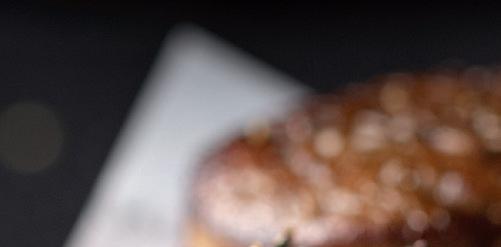

“I hope that it gives people something else to think about if they are having a difficult time right now,” Poe said. “Art can really provide a balm for times like this and I hope that it can be a balm for someone.”
Even before it was released, Amazon announced that they were developing a television show based on the film.













count on, and we can’t gather,” Biko said. “It forces the artists in general to really get creative as far as what it is they want to put forth and keep people engaged.”
Like plenty of other DJs, Biko has been relying on social media to stay connected with his audience.
“It’s an outlet for artists to still present their stuff – singers, musicians MCs, poets, visual artists, DJs obviously –and curators,” Biko said.
The live stream scene was something he had done a few times, but these days, it’s how the audience who would normally catch a set from him at Blank Space or The Ready Room tunes in.
Boogie Down Productions DJ and famed hiphop producer D-Nice went viral with a few epic Instagram Live sessions – including one virtually co-hosted by former First Lady Michelle Obama to encourage voting. Now the mix sessions are a regular part of the virtual escape social media has provided during Stay at Home Orders that have kept the world indoors to fight off COVID-19.
Through Selah, Poe hopes to bring a new normal of representation.
“Some people are going to hate it. Some people are going to love it,” Poe said. “But I think that one thing nobody can take away is that there is a black girl leading this movie and she is telling you who she is and taking up space and not apologizing for it. The world finds a way to find a problem with black women no matter what we do, so we may as well do what we want.”
Selah and the Spades will be available for streaming on Amazon Prime Video starting Friday, April 17. The film is rated R with a running time of 97 minutes.
“It’s a wild feeling because when I was writing this story, I kept saying to myself, ‘This would make a really good TV show,” Poe said. “The world felt so rich. Even as I was writing this story for the feature film, there were all these different side stories that I knew would never fit into the feature that I would just jot down like, ‘one day, maybe I will be able to use these things.’ In a way I feel fortunate that I get to keep my scraps for now. It’s kind of a dream come true.”
to donate via Cash app. He got the idea to use Facebook Live to help businesses affected by social distancing from his wife, Halima Martin Gates. He has raised several hundred dollars by dedicating a spin session dedicated to fundraising for SweetArt Café, The Black Rep and The After Experience Spa. This unprecedented time has been terrible, but the rainbow in the cloud of the COVID-19 storm for him has been the reaction of his and other DJ’s life’s work.
“People are really seeming to either discover or rediscover the power of DJs,” Biko said. He said a lot of people who go to bars and clubs are not necessarily there for the DJs. They are there for the experience. But this time is waking up to the idea that wow this feeling is largely due to this person’s curated playlist.
n “Can you imagine doing this without having social media as an outlet? People would be going crazy,” Biko said. “I’m grateful to be in the time where this ability to connect is here so you don’t feel so isolated.”
“It reminded people that this art form matters,” Biko said. “And – even in a time like this –it has power to change people’s attitudes and provide these really great vibes.”
“It’s been interesting to see how it affects people and how the audience really appreciates us doing it,” Biko said. “It’s awesome to see that people are really looking forward to these live streams. It’s a good thing that we were able to utilize this type of way. It’s terrible that it had to happen because of such an awful thing.”
Biko hosts spin sessions via Facebook Live several times a week.
“Can you imagine doing this without having social media as an outlet? People would be going crazy,” Biko said. “I’m grateful to be in the time where this ability to connect is here so you don’t feel so isolated.”
He has also used the evening sessions to raise funds for black businesses by asking listeners
Townsend is expecting to be pulled in many directions once the COVID-19 cloud lifts, but she doesn’t expect it to be automatic.
“The flip side of that you also have consumers have to come out of this too,” Townsend said. “A lot of people that buy tickets for events and concerts right aren’t working right now. Are they going to jump up and spend their money on events? They have to restore themselves financially.” Townsend is using whatever time she will have to sideline her business to rest, restore and strategize so that she can hit the ground running.
“I’m working on figuring out a way to build myself and my business so that when the green light is on again, I will be able to go and go and be okay.”

By Maria Russell Of The Missouri Historical Society
Annie Malone’s story is a classic pull-yourself-up-by-your-bootstraps narrative, the kind Americans love to tell. But the heart of her story reveals something more: a woman’s commitment to her community and her efforts to pull others up with her.
Annie Turnbo Malone was born on August 9, 1869, the second-youngest child in a large family. Her parents, who had previously been enslaved, died when she was still very young, so she was raised by an older sister in Peoria, Illinois.
As Malone was growing up, many black women and girls were dealing with hair loss, brittleness, scalp disease, and hair damage from stress, illness, and the harsh chemicals and techniques marketed to straighten black hair. Wanting to remedy this, the young entrepreneur experimented on her sisters and their friends, developing mixtures to not only encourage hair growth and health but also soothe and reverse chemical burns and scalp disease.
With a burgeoning reputation for good results and a perfected recipe for her “Wonderful Hair Grower,” Malone moved to Brooklyn, Illinois, an African American town popularly known as Lovejoy after the abolitionist Elijah Lovejoy. She launched her Poro business by marketing her product door to door and recruiting locals to advertise its success.
As news spread about the upcoming 1904 World’s Fair, Malone must have seen a tremendous opportunity for Poro. She moved to St. Louis in 1902 and continued her strategy of hiring local agents. One of those agents, Sarah Breedlove, started selling her own hair-growth elixir under her married name, Madam C. J. Walker, and became extremely successful in her own right. The Netflix series Self Made: Inspired by the Life of Madam C. J. Walker, starring Octavia Spencer, highlights the conflict between Malone and Walker, but also sheds light on the power of African American women as entrepreneurs and business leaders.
Through ad campaigns, press conferences, and a tour of the South to train women as Poro agents, Poro haircare and skincare products became even more popular. Their most distinguishing feature? An emphasis on African hairstyles and black beauty, compared to other products that focused on straightening hair and lightening skin to adhere to white beauty ideals. Many Poro ads also emphasized opportunities for black women to earn income, gain independence, and build self-esteem as Poro agents. By 1918, construction began on Poro College, near the new location of Sumner High School in the Ville neighborhood. In addition to serving as the headquarters for manufacturing and shipping Poro products, the college was a training center for Poro sales agents. The campus included dormitories, emergency-first-aid rooms, and a student cafeteria. A 500-seat auditorium, committee rooms, and rooftop garden were open for public use.
As the first African American woman to become a multimillionaire, Malone was well known for her generosity. She helped her employees with mortgages and rewarded workers who bought homes for their parents and siblings.
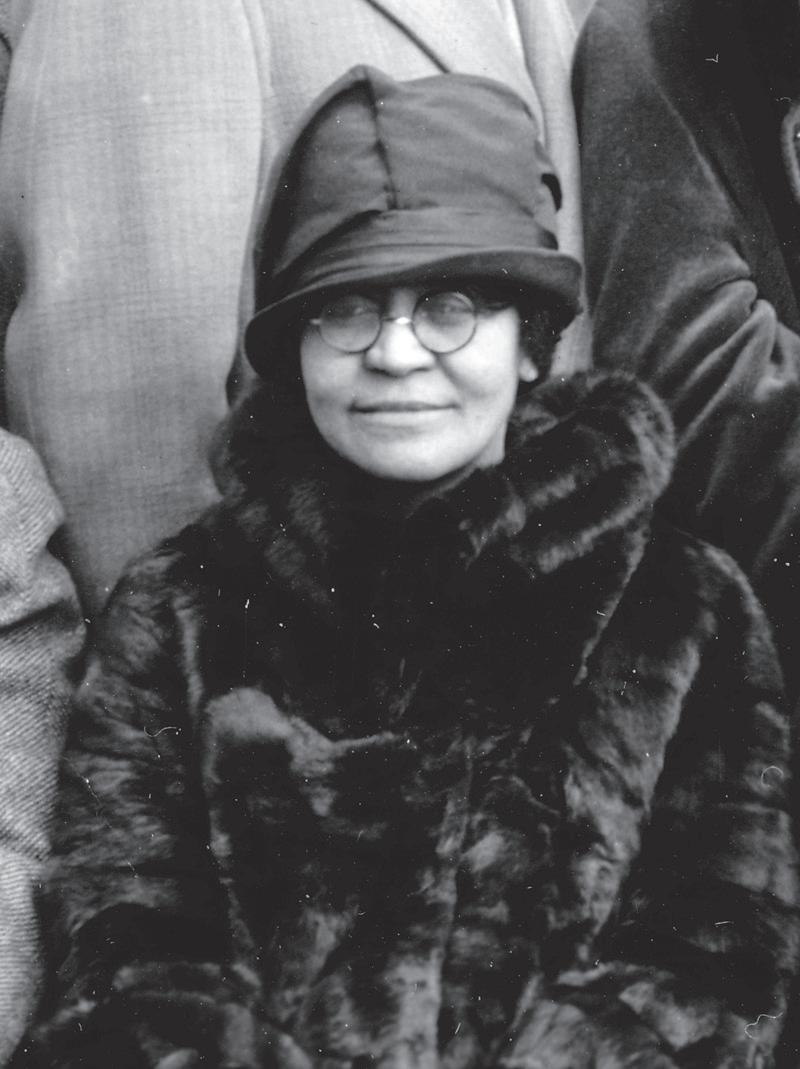
Black institutions, including the St. James AME Church, the Pine Street YWCA, and Howard University Medical School, received large donations from Malone. At one point the St. Louis Argus reported that she had financially supported at least two students at every African American land-grant college in the nation.
Malone also donated land and money to the St. Louis Colored Orphan’s Home and assisted the institution in moving to its permanent location on Goode Avenue (later renamed Annie Malone Drive). She served as president of the board for the Orphan’s Home for nearly 25 years, from 1919 to 1943.
Financial difficulties eventually led Malone to move her Poro headquarters to Chicago, but she returned to St. Louis every year for the annual May Day parade, a fundraiser for the Orphan’s Home. In 1946 the institution was officially renamed the Annie Malone Children’s Home.
Malone passed away in 1957, and the site of her business venture was eventually replaced with residences. Although the Poro empire itself didn’t survive, Malone’s legacy of philanthropy and community building lives on here in St. Louis.
On Thursday, April 23, at 6pm, join the Missouri History Museum online for Hollywood Versus History, a panel discussion exploring what responsibilities, if any, Hollywood has in telling the stories of our past. A’Lelia Bundles, great-great-granddaughter of Madam C. J. Walker, and Linda Nance, founding president of the Annie Malone Historical Society, will discuss the Netflix series Self Made. For information about how to join this free Zoom meeting, visit mohistory.org/events/hollywood-versus-history. This column was originally published at History Happens Here, the blog of the Missouri Historical Society.


Where visitors can find links to attractions offering virtual experiences
By Jennifer Poindexter For The St. Louis American
In these unprecedented times, we can all use a little escape. Since we can’t experience our incredible St. Louis attractions in-person, Explore St. Louis has created an online hub to bring the attractions to you. Explore St. Louis’ Virtual St. Louis is a one-stop-shop web page where visitors can find links to attractions offering virtual experiences. From the Gateway Arch to the Cahokia Mounds Museum and beyond, you can watch the playful otters at the St. Louis Aquarium, learn the game of chess from a master with the Saint Louis Chess Club, stand in the spotlight with Broadway stars at STAGES St. Louis, or spend a tranquil afternoon among the cherry blossoms at the Missouri Botanical Garden, and more. One of my personal favorites, The Saint Louis Zoo, will #BringTheStlZooToYou. Its «zootube» page gives viewers a chance to experience the animals from a keeper’s perspective, as the animal care team shares photos and videos of animals over the coming weeks. You can also peek in on the penguins as the Zoo hosts a daily live penguin cam from 9 a.m. to 5 p.m. Purina Farms is one of the region’s most popular attractions for families and animal lovers. While you’re at home self-quarantining, the team at Purina Farms will be bringing you the best of everything you love about Purina to you virtually! Tune in each day for something

new including Monday Animal connections and Wednesdays Amazing Canines. Check out the schedule online.
In addition to being entertained, many attractions featured on Virtual St. Louis promote educational opportunities.
Wednesdays at 10 a.m. the Zoo hosts
STLZOOms where you’re invited to join one of the Zoo’s Educators from their homes to learn more about animals and how amazing they are.
At The Magic House Children’s Museum the fun, adventure, and learning never ends. This Kirkwood institution has been bringing family-friendly entertainment and educational opportunities to area residents and visitors since 1979. Visit their many online sites offering up engaging kid-focused videos and content to help them pass the time as they learn along the way.

The City Museum On Air invites you to make art, go on a guided tour, DIY a time capsule, peek behind the scenes, watch the Cassilly Crew at work, and help the City Museum inspect the slides. Every Monday through Friday, the City Museum staff, crew, artists, and historians go live on Facebook to share stories, offer free classes and more.
Attractions are being added to the website daily so to get the word out, Explore St. Louis introduced the “Daily Explorer”, a daily email newsletter that highlights various virtual experiences around St. Louis. If you would like to add your name to the list, you can sign up via the Virtual St. Louis webpage.
Social distancing doesn’t have to keep you from exploring St. Louis. Virtual St. Louis is a guide to all the amazing things St. Louis has to offer. We hope it will help keep everyone connected while we weather this storm together. You can explore St. Louis from your phone, laptop or tablet simply by visiting www.explorestlouis/virtual-st-louis.
Jennifer Poindexter is direction of Convention Services at Explore St. Louis.

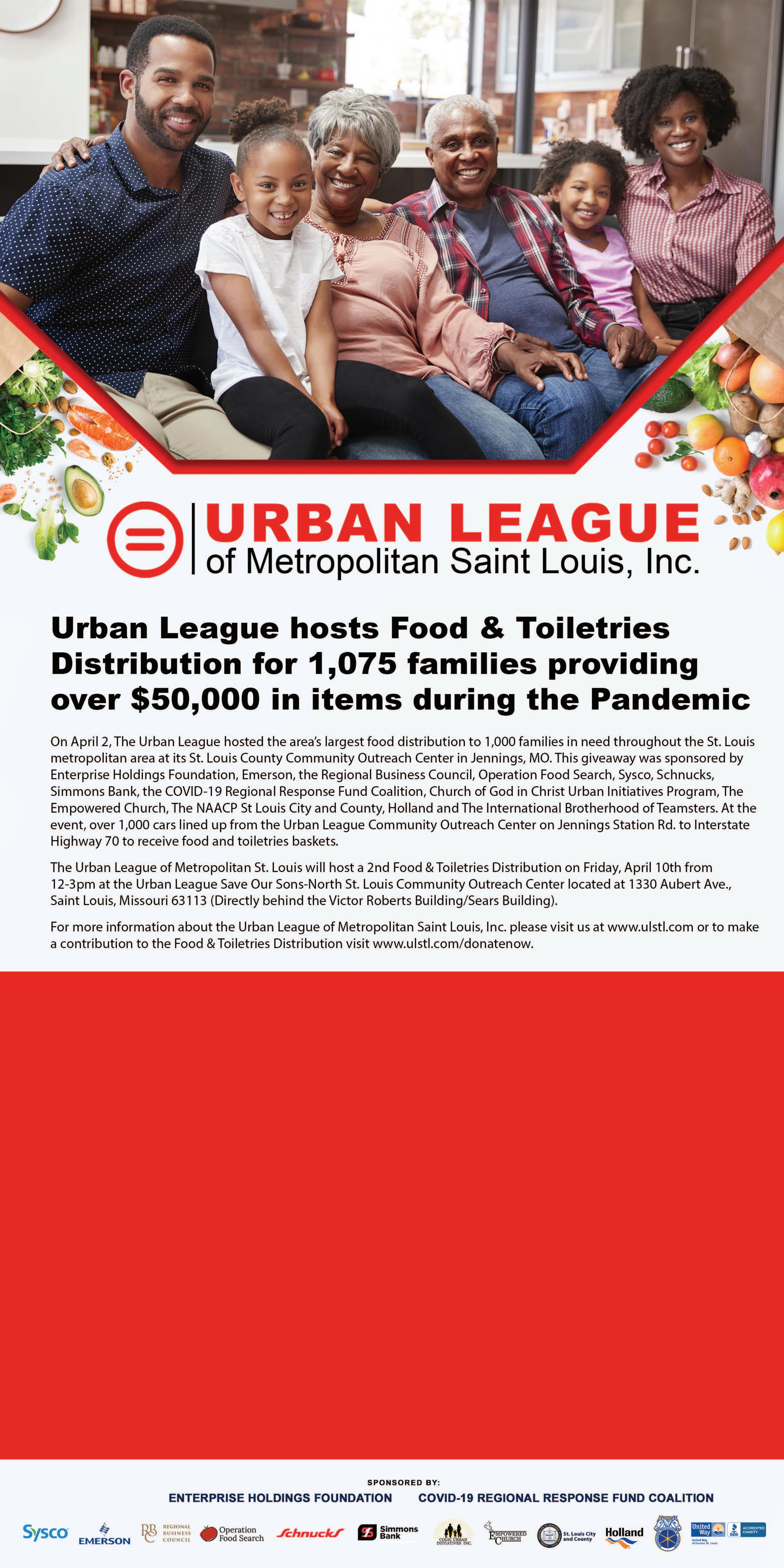

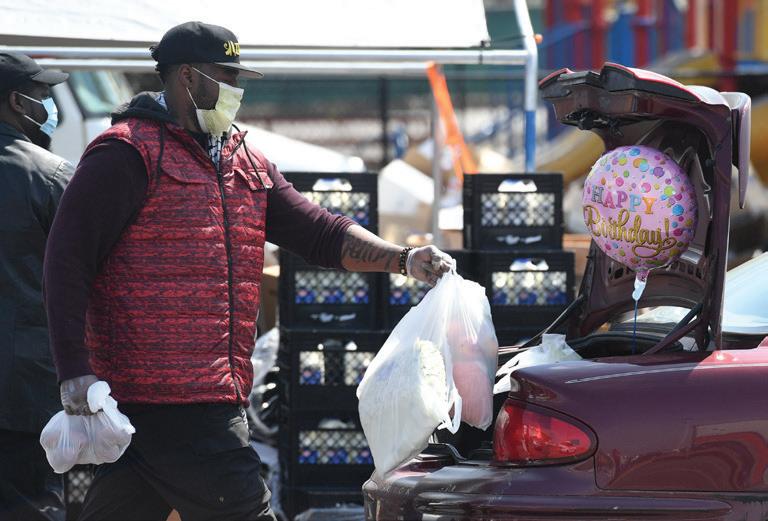
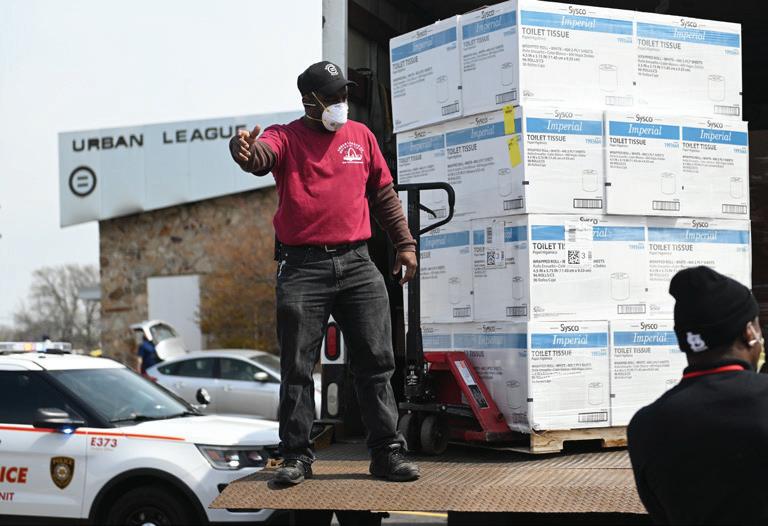
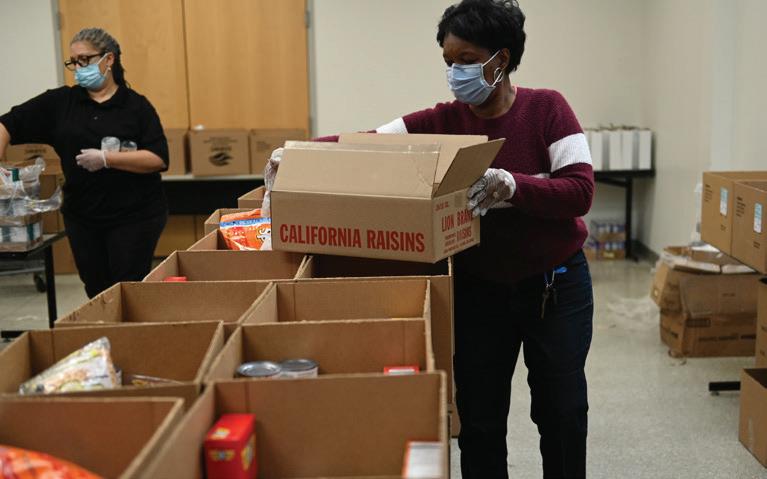
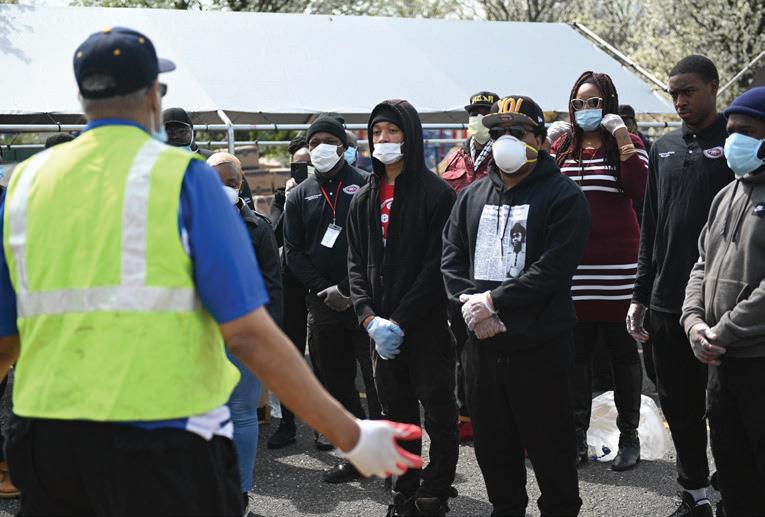



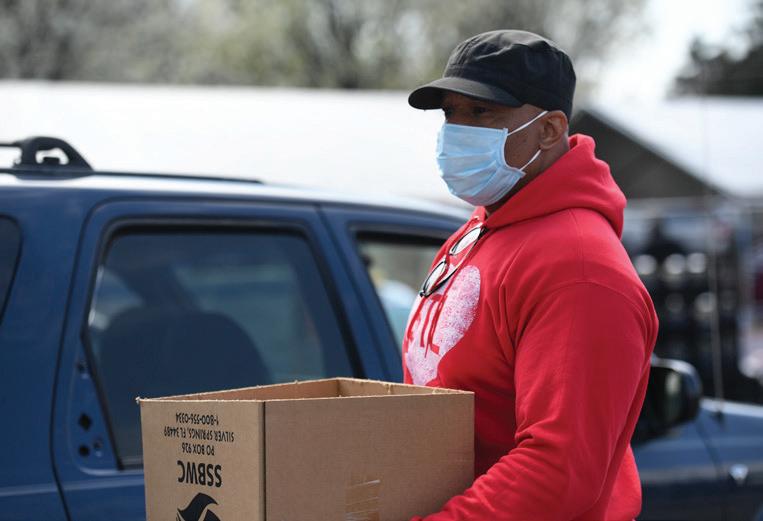
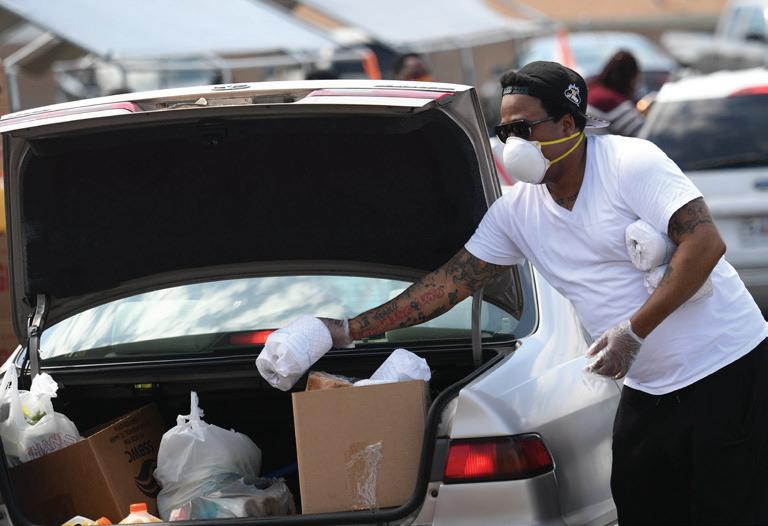








St. Louis Lambert International Airport
Sealed proposals will be received by the Board of Public Service, Room 208, City Hall, 1200 Market Street, St. Louis, Missouri, 63103 until 1:45 PM, CT, on May 12, 2020, then publicly opened and read. Plans and Specifications may be examined on the Board of Public Service website http://www.stl-bps.org (BPS On Line Plan Room) and may be purchased directly throughthe BPS website from INDOX Services at cost plus shipping. No refunds will be made.
Bidders shall comply with all applicable City and State laws (including DBE/MBE/WBE policies). Mandatory prebid meeting will be held on Tuesday, April 21, 2020, at 10:00 A.M. in the Ozark Conference Room (AO-4066) at the Airport Office Building, 11495 Navaid Rd., Bridgeton, MO 63044.
All bidders must regard Federal Executive Order 11246, “Notice of Requirement for Affirmative Action to Ensure Equal Employment Opportunity”, the Equal Opportunity Clause” and the “Standard Federal Equal Employment Specifications” set forth within and referenced at www.stl-bps.org (Virtual Plan Room).(Announcements).
Paric Corporation is seeking proposals for the following project: Lottes Health Science Library – 1st Floor Phase One Renovation for the University of Missouri.
This is an approximately 7,000 sf renovation of the existing School of Medicine and Anesthesiology offices.
The scope of work includes but is not limited to demo, carpentry, casework, doors/frames/hardware, drywall, ceramic tile, ACT, carpet, painting, fire protection, plumbing, HVAC and electrical..
This project has a diversity participation goal of 10% MBE and 10% combined WBE, DBE, Veteran Owned Business and 3% SDVE.
Bids for this project are due on April 15th, at 10:30 p.m. For any questions or would like to find out more detailed information on this opportunity, please contact Evan Chiles at 816-878-6003 or emchiles@paric.com.
All bids should be delivered to Paric via e-mail (bids@paric.com) or fax (816-878-6249).
PARIC CORPORATION
Join a great team with an Employees First approach that’s helped make St. Peters one of the best places to live in America! Various FT and PT positions with competitive pay at multiple city facilities including St. Peters Rec-Plex, Water’s Edge Banquet Center and St. Peters Golf Club.
To view all current openings and to apply, please visit www.stpetersmo.net/Jobs.
Notice is hereby given that The Metropolitan St. Louis Sewer District (District) will receive sealed bids for Re-Bid Louisiana and Holly Hills Storm Sewer under Letting No. 11522-015.1, at this office, 2350 Market Street, St. Louis, Missouri 63103, until 02:00 PM on Thursday, May 14, 2020, at a place designated. Bids will be received only from companies that are pre-qualified by the District’s Engineering Department for: SEWER CONSTRUCTION - St. Louis City Drain Layers License Required Plans and Specifications are available for free electronic download. Please go to MSD’s website and look for a link to “ELECTRONIC PLANROOM.” Plans and Specifications are also available for viewing or purchase at Cross Rhodes Reprographics located at 1712 Macklind Avenue, St. Louis MO 63110. All bidders must obtain a set of plans and specifications in order to submit a bid in the name of the entity submitting the bid.
The Metropolitan St. Louis Sewer District is an Equal Opportunity Employer.
METROPOLITAN ST. LOUIS
SEWER DISTRICT
Notice is hereby given that the Metropolitan St. Louis Sewer District is accepting proposals in the Purchasing Division, 2350 Market Street, St. Louis, Missouri 63103-2555 until 10:00 a.m. on May 14th, 2020 to contract with a company for: Lockbox Services. Specifications and bid forms may be obtained from www.msdprojectclear.org, click on the “DOING BUSINESS WITH US” link, (View Non-Capital Bids (Goods & Services). The bid document will be identified as 10367 RFP. If you do not have access to the internet, call 314.768.2735 to request a copy of this bid.
Metropolitan St. Louis Sewer District is an Equal Opportunity Employer.
CONSTRUCTION INC.
Requests subcontractor and or material supplier quotations from Illinois Department of Transportation Certified subcontractors, suppliers and Disadvantaged Business Enterprises for the letting to be held April 24, 2020. Interested parties should contact Keller Construction at (618) 656-0033. All quotations must be submitted by 4:30 PM Thursday April 23, 2020. Keller Construction is an equal opportunity employer.
Bids for TASMG Readiness Center a t M i s s o u r i National Guard AVCRAD Facility, SpringfieldBranson National Airport, Project No. T1809-01 will be received by FMDC, State of MO, UNTIL 1:30 PM, 5/21/20 via MissouriBUYS. Bidders must be registered to bid. For specific project information and ordering plans, go to: http://oa.mo. gov/ facilities
Bids for REBID OF Install Nature Park, Missouri School for the Blind, St. Louis, Missouri, Project No. E1703-01 will be received by FMDC, State of MO, UNTIL 1:30 PM, 5/12/2020 via MissouriBUYS. Bidders must be registered to bid. For specific project information and ordering plans, go to: http:// oa.mo. gov/facilities
Great Rivers Greenway is requesting Bids for Graphics Fabrication & Installation Services
Go to www.greatriversgreenway.org/ jobs-bids/ and submit by May 4, 2020.
The City of Crestwood is seeking bids for the 2020 Mill & Overlay Project. Qualified contractors may obtain a Project Manual online at www.cityofcrestwood.org or in person at the City of Crestwood Government Center Lobby located at #1 Detjen Dr. St. Louis, MO 63126. Bids are due by 10:00 A.M., CDT, on Thursday May 14, 2020. Please call (314)729-4720 for more information.
METROPOLITAN ST. LOUIS
SEWER DISTRICT
Notice is hereby given that the Metropolitan St. Louis Sewer District is accepting proposals in the Purchasing Division, 2350 Market Street, St. Louis, Missouri 63103-2555 until 10:00 a.m. on April 22, 2020 to contract with a company for: REBUILD/ REPAIR THICKENER 1 Specifications and bid forms may be obtained from www.msdprojectclear.org, click on the “DOING BUSINESS WITH US” link, (View Non-Capital Bids (Goods & Services). The bid document will be
DISTRICT OF ST. LOUIS COUNTY ACCEPTING SEALED BIDS (SSD# 110-20)
Notice to contractors, Special School District is accepting bids for Interior Upgrades at Litzsinger, Ackerman & Southview Schools. For details, please visit the website at www.ssdmo.org/rfps.html
Great Rivers Greenway is requesting qualifications for Property Appraisal Companies and Title and Closing Companies. Go to www.greatriversgreenway.org/ jobs-bids/ and submit by May 1, 2020.
City of Crestwood, 1 Detjen Drive, Crestwood, MO 63126 is seeking bids for general works, mechanical, electrical and plumbing bid packages at the Crestwood City Hall. Bids due 5/12/20 by 3:00 p.m. A pre-bid meeting will be held on 4/28/20 by appointment only. Project manuals, registration and questions through Katie Aholt (katie@navigatebuildingsolutions.com or 636-359-8538).
(EWG) seeks comment on the
to the St. Louis Region’s Coordinated Human Services Transportation Plan (CHSTP). The public is invited to view the CHSTP at a series of virtual open-house meetings that can be accessed at www.ewgateway.org/chstp: Thu., 4/16/20: 11:00 AM to 12:00 PM; Wed., 4/22/20: 4:00 to 5:00 PM. The public comment period begins Mon., 3/30/20 and ends Thu., 4/30/20. The CHSTP will be available on the website at www.ewgateway.org. Comment forms will be available on the website and at the meetings. Comments must be received or postmarked by midnight Thu., 4/30/20. Send comments to CHSTP@ewgateway.org or East-West Gateway Council of Governments, Attn: CHSTP, 1 S. Memorial Drive, Ste. 1600, St. Louis, MO 63102.
EWG is committed to ensuring that all meetings are both ADA and LEP accessible. To request a reasonable accommodation for a meeting, please contact EWG’s Title VI Coordinator at least 48 business hours prior to the meeting at (314) 421-4220 or (618) 274-2750 or titlevi@ewgateway.org.
EWG fully complies with Title VI of the Civil Rights Act of 1964 and related statutes and regulations in all programs & activities. For more information, or to obtain a Title VI Nondiscrimination Complaint Form, see www.ewgateway.org/titlevi or call (314) 421-4220 or (618)274-2750.
OFF-SYSTEM BRIDGE MAINTENANCE FEDERAL
PROJECT NO. BRO-B115 (15) BPS PROJECT NO. 2013-40-096
Sealed proposals will be received by the Board of Public Service, Room 208, City Hall, 1200 Market Street, St. Louis, Mo. Until 1:45 PM, CT, on May 19, 2020, then publicly opened and read. Plans and Specifications may be examined on the Board of Public Service website http:// www.stl-bps.org (BPS On Line Plan Room) and may be purchased directly throughthe BPS website from INDOX Services at cost plus shipping. No refunds will be made. There will be no pre-bid conference. Bidders shall comply with all applicable City,State and Federal laws (including MBE/WBE policies).
All bidders must regard Federal Executive Order 11246, “Notice of Requirement for Affirmative Action to Ensure Equal Employment Opportunity”, the Equal Opportunity Clause” and the “Standard Federal Equal Employment Specifications” set forth within and referenced at www.stl-bps.org (Virtual Plan Room).(Announcements).
Notice is hereby given that the Metropolitan St. Louis Sewer District is proposing to procure Firstech for our Walk-in Payment Processing Services for our pay-stations. The District is proposing a single source procurement for this service. Any inquiries should be sent to strenz@stlmsd.com.
Metropolitan St. Louis Sewer District is an Equal Opportunity Employer.
TO ADVERTISE YOUR JOBS, CAREER FAIRS, WORKSHOPS CALL ANGELITA AT 314-2895430
Goodwin Bros. Construction Co. is requesting subcontract bids and/or material quotations from qualifying Minority Business Enterprises and Women Business Enterprises for relevant phases of work for Metropolitan St. Louis Sewer District, Deer Creek Sanitary TunnelPump Station Project, Contract Letting No. 12615-015.1. Interested parties should contact the Goodwin Office at (636) 931-6084. A pre-bid meeting for all interested MWBE’s will be held at Goodwin Brothers office at 4885 Baumgartner Road, St. Louis, MO 63129 at 8:00 am on Thursday, April 2, 2020. Subcontractor/Supplier bids are due April 9, 2020 at 5:00 p.m.
An Equal Opportunity Employer
SEWER DISTRICT
ST. LOUIS
Notice is hereby given that the Metropolitan St. Louis Sewer District is accepting bids in the Purchasing Division, 2350 Market Street, St. Louis, Missouri 63103-2555 until 11:00 a.m. on April 27th, 2020 to contract with a company for: Parts and Service Agreement: Small Engine and Small Tool Items.
Specifications and bid forms may be obtained from www.msdprojectclear.org, click on the “DOING BUSINESS WITH US” link, (View Non-Capital Bids (Goods & Services). The bid document will be identified as 10344 RFQ. If you do not have access to the internet, call 314.768.6254 to request a copy of this bid.
Metropolitan St. Louis Sewer District is an Equal Opportunity Employer.
CF Vatterott Construction Co. 10143
Paget Dr. St. Louis, Mo. Is seeking subcontractor bids for new home construction in Lemay. St. Louis, Mo. Section 3 Minority, Women & Disadvantaged Businesses are encouraged to bid. Plans & Specs can be viewed at CF Vatterott office.10143 Paget Dr. St. Louis, Mo 63132. Bids are due by April 15 and are subject to section 3 requirements. Intended qualified applicants for subcontractors are selected without regard to race, sex, color, age, religion, or national origin.
City of St. Louis Choice Neighborhood Grant Section 3 Management Improvements
The City of St. Louis requests proposals from qualified service providers capable of preparing and assuring registration by Choice Neighborhood residents and other residents of the City of St. Louis as Section 3 Residents and Businesses for federally-funded programs available at both the Community Development Administration (CDA) department and the St. Louis Housing Authority. The activity will be funded over a 3-year period by a Choice Neighborhood Implementation Grant (CNIG) from the U.S. Department of Housing and Urban Development (HUD) administered by the CDA. The five-phase funding completion deadline is December 2022. CDA will award a contract to the lowest and most responsive proposal. Provider selection is subject to the availability of federal funding and is at the sole discretion of the City of St. Louis.
The RFP in its entirety can be found on the Community Development Administration (CDA) website: https://www.stlouis-mo.gov/cda/ Proposals must be submitted no later than 4:00 p.m. on April 30, 2020 to Matt Moak, Community Development Administration, 1520 Market St. – Suite 2000, St. Louis, MO 63103. Questions concerning the RFP may be directed to MoakM@stlouis-mo.gov
CDA does not discriminate based on race, color, national origin, religion, sex, disability, familial status or sexual orientation in the administration of the program.
CDA is an Equal Opportunity Agency
Minority Participation is Encouraged
City of St. Louis Healthy Home Repair Program Appraisals
The City of St. Louis requests proposals from state licensed real estate appraisers to conduct “after-rehab” appraisals to determine the value of properties that receive assistance through the City’s Healthy Home Repair Program (HHRP). The activity is funded by an annual allocation from the U.S. Department of Housing and Urban Development (HUD), and administered by the Community Development Administration (CDA). CDA will award a contract to the lowest and most responsive proposal. Project selection is subject to federal funding and is at the sole discretion of the City of St. Louis.
The RFP in its entirety can be found on the Community Development Administration (CDA) website: https://www.stlouis-mo.gov/cda/. Proposals must be submitted no later than 4:00 p.m. on April 30, 2020 to Matt Moak, Community Development Administration, 1520 Market St – Suite 2000, St. Louis, MO 63103. Questions concerning the RFP may be directed to MoakM@stlouis-mo.gov
CDA does not discriminate based on race, color, national origin, religion, sex, disability, familial status or sexual orientation in the administration of the program.
CDA is an Equal Opportunity Agency
Minority Participation is Encouraged
New Construction Section 3 / MBE /WBE Encouraged 20 Single Family Homes –Doniphan, MO For Bid Information: 636-931-4244 or zventura@vendev.cc Double Diamond Construction 1000 A Truman Blvd. Crystal City, MO 63019
VACANT LAND FOR SALE OR LEASE
1014 Spruce Street, St. Louis, MO
Request for Proposals: www.stltreasurer.org/ avada_portfolio/request-for-proposal-topurchase/
PINNACLE CONTRACTING
1815 LOCUST
1815 Locust Street, St. Louis, MO 63103
Due date: 4/28/20 at 2:00pm
Pre-bid walkthroughs: 4/13 and 4/20 from 1pm-3:15pm
*Please visit the Building Connected Project page to access the sign up sheet for the walkthrough Description: Pinnacle Contracting is accepting bids for: 3-story, 70-unit historic rehab with sitework. The following trades have been awarded: Plumbing, Fire Protection, HVAC, and Electrical. Project to start 6/15/20 with an overall 10.5 month duration. Solar panels, membrane roofing, historic aluminum windows, and landscaping are by owner. Project is Sales Tax Exempt. HUD/Davis Bacon Prevailing Wage is required. NHBS Green Practices are required. MBE/WBE participation is required per Mayor’s Executive Order.
*You may view the plans/specs and submit bids on Building Connected. For any questions please contact Keana at bids@pinnaclecontracting.com, or 314-783-8000 ext. 0.
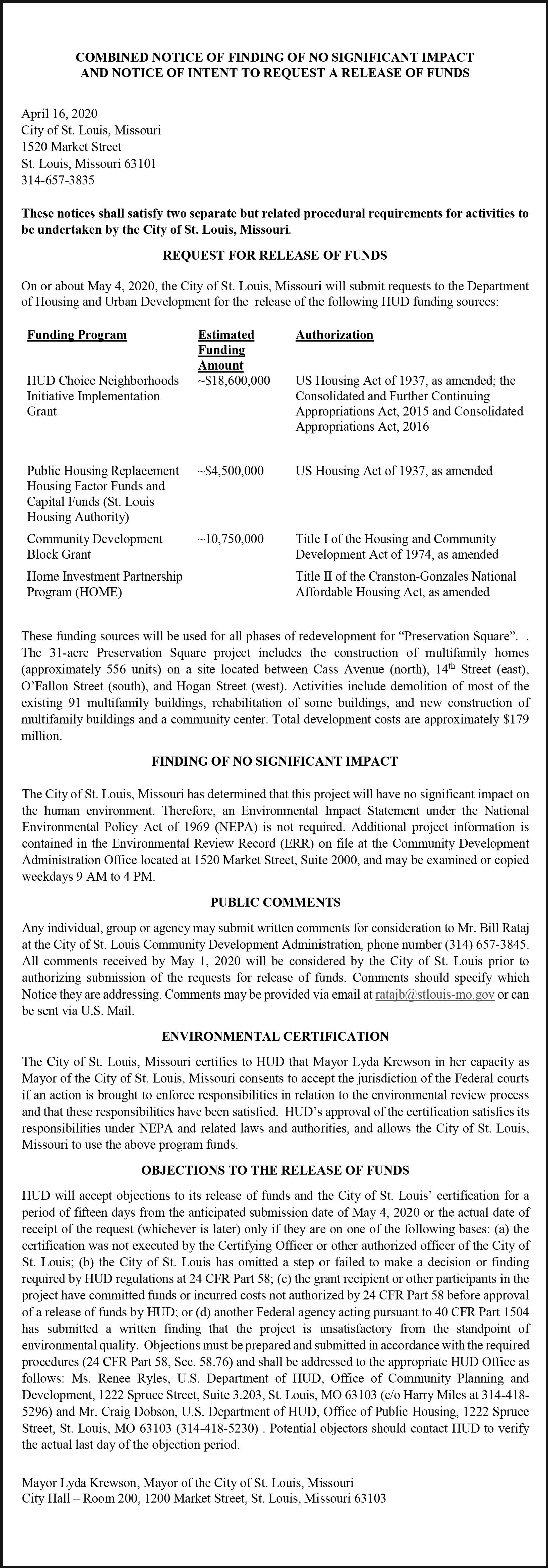


NOTICE TO DIVERSE BUSINESSES ADVERTISEMENT
QUALIFIED DIVERSE BUSINESSES FOR THE NOTICE TO SMALL (SBE), SMALL
DISADVANTAGED (SDB), MINORITY (MBE), WOMEN-OWNED (WOSB), VETERAN OWNED (VOSB), SERVICE DISABLED VETERAN OWNED SMALL (SDVOSB), HISTORICALLY BLACK COLLEGES AND UNIVERSITY MINORITY INSTITUTIONS, AND HUBZONE SMALL (HSB) BUSINESSES, RIVER CITY CONSTRUCTION, L.L.C., 101 HOFFER LANE, EAST PEORIA, IL, (309) 694-3120 (PHONE) (309) 694-1332 (FAX) IS SEEKING QUALIFIED SMALL AND SMALL DISADVANTAGE BUSINESSES, WOMEN OWNED SMALL BUSINESSES, VETERAN OWNED SMALL BUSINESSES, HISTORICALLY BLACK COLLEGES AND UNIVERSITY MINORITY INSTITUTIONS, HUBZONE AND SERVICE DISABLED VETERAN OWNED SMALL BUSINESSES FOR THE ADD/ALTER CONSOLIDATED COMMUNICATIONS FACILITY B1575, SCOTT AIR FORCE BASE, IL, FOR THE SUBCONTRACTING OPPORTUNITIES IN THE FOLLOWING AREAS: ASBESTOS, CONCRETE, MASONRY, METALS, REINFORCING, STEEL, CARPENTRY, DOORS, SPECIALTIES, EQUIPMENT, DEMOLITION, EXCAVATION, PAVING, LANDSCAPE, COMMUNICATIONS, INTEGRATED AUTOMATION, SECURITY, FIRE SUPPRESSION, FENCING, MASONRY, ROOFING, GLASS, DRY WALL, FLOORING, PAINTING, FURNISHINGS, UTILITIES, PLUMBING, MECHANICAL, AIR BARRIER VEHICLES, ELECTRICAL. ALL INTERESTED AND QUALIFIED SMALL AND SMALL DISADVANTAGE BUSINESSES, WOMEN OWNED SMALL BUSINESSES, VETERAN OWNED SMALL BUSINESSES, HUBZONE AND SERVICE DISABLED VETERAN OWNED SMALL BUSINESSES SHOULD CONTACT, IN WRITING, (CERTIFIED LETTER, RETURN RECEIPT REQUESTED) KENT KAMPWORTH OR ERIC BURSOTT, TO DISCUSS THE SUBCONTRACTING OPPORTUNITIES. ALL NEGOTIATIONS MUST BE COMPLETED PRIOR TO THE BID OPENING DATE
The St. Louis County Port Authority (the “Port”) requests proposals from qualified firms to perform a geotechnical investigation and site evaluation related to the Port’s proposed sale and/ or redevelopment of an approximately 140-acre property located at the former Jamestown Mall site in St. Louis County, Missouri 63034. A five percent bid preference may be available to certified MBE firms. A copy of the complete RFP is available at https:// stlpartnership.com/rfp-rfq/. Proposals must be received no later than 3:00 PM on Friday, April 24, 2020. St. Louis Economic Development Partnership Equal Opportunity Employer
ICS Construction is seeking firms interested in bidding the tenant build-out of a “Confidential” Project at Cortex. Bids must be submitted by no later than 4:00pm on April 29, 2020. Interested bidders may contact Todd Zavaglia at 314-534-6664 or tzavaglia@ics-stl.com.
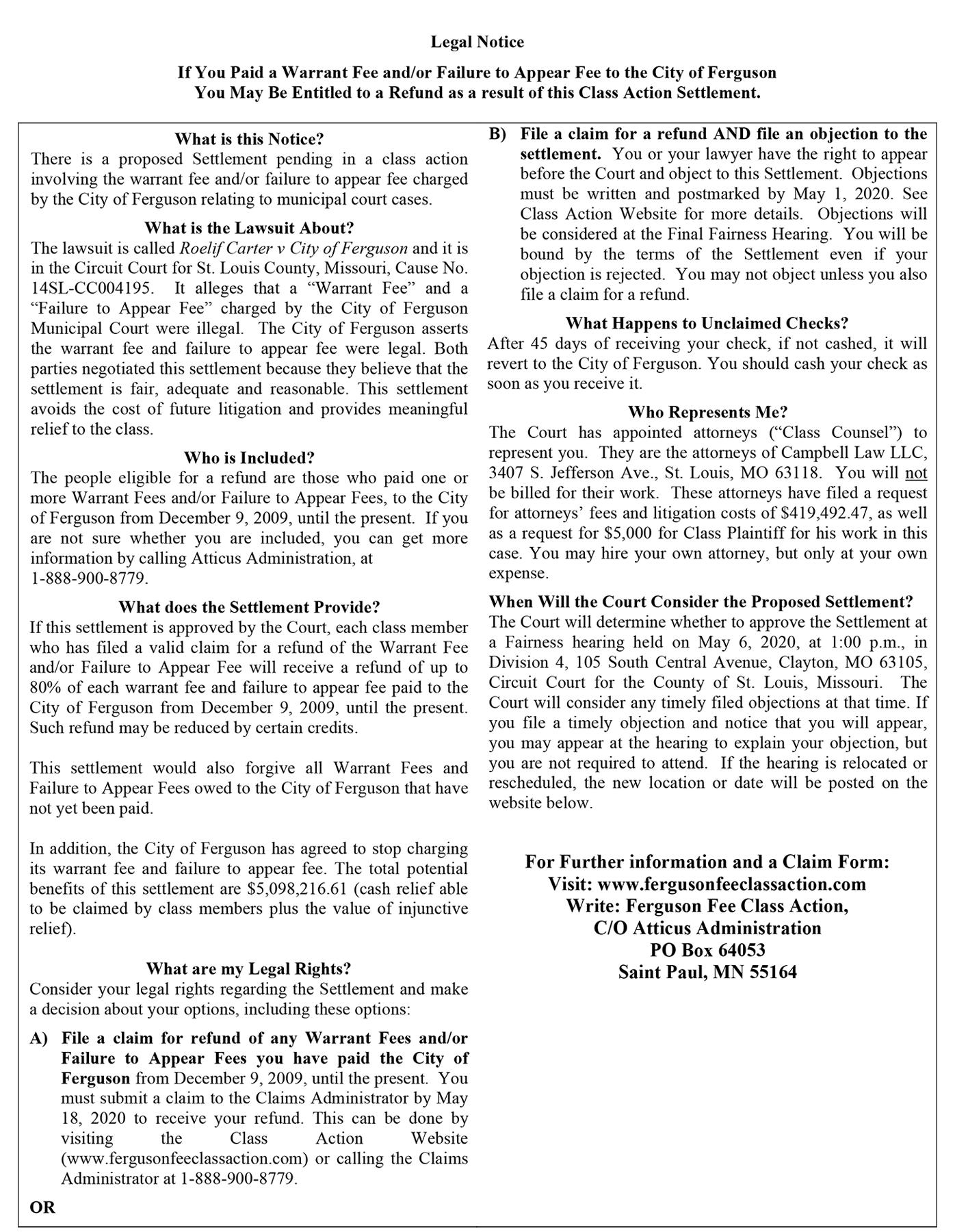

Advertised herein is subject to the Federal Fair Housing Act, which makes it illegal to advertise any preference, imitation, or dis- crimination because of race, color, religion, sex, handicap, familial\status, or national origin, or intention to make any such pref- erence, limitation, or discrimination.“We will not knowingly accept any advertising for real estate which is in violation of the law. All persons are hereby informed that all dwellings advertised are available on an equal opportunity basis.”

As we enter our fourth week of social distancing, the Partlyline Gallery dipped into recent archives for the featured photos this week’s edition. St. Louis comedy staple Jessie Taylor with comedienne, internet sensation and television star Jess Hilarious after they performed at The Pageant in November for the Love and Laughter Holiday Comedy Explosion.





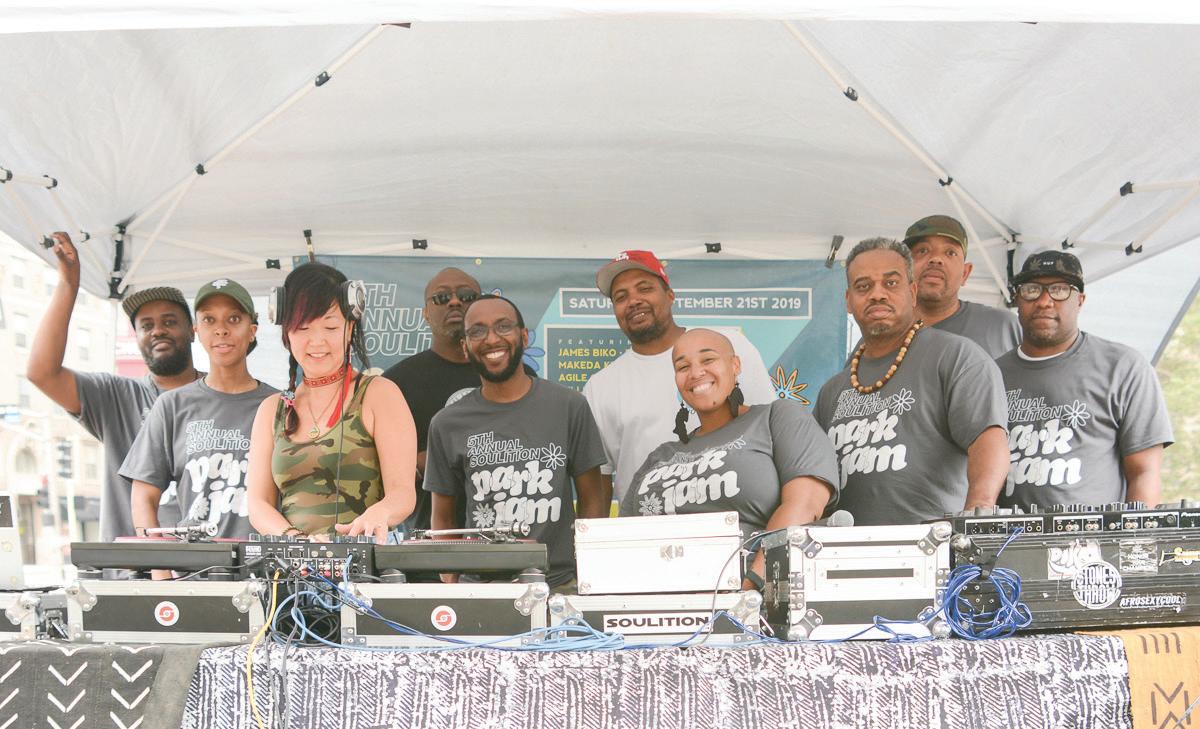

Coronavirus cabin fever. Can you believe we haven’t been in these streets for a whole month? Of course, y’all can. Some of y’all have had y’all’s Easter Day Party outfits all over “the Book” and the “Gram.” We saw ‘em? So, you know that means you can’t wear them next year, right? But seriously, How are y’all holding up? I meant
to ask y’all to send me a snippet or two from your quarantine chronicles for possible publishing to dshante@stlamerican.com. I am very interested in how y’all are passing the time. Please note: two hundred words or less will be plenty. I know one thing, I’m praying for another at-home viral sensation, because the “Don’t Rush” challenge is beyond fashionably late. If you did it before this week, that’s fine, but nobody will be checking for it after your pre-and-post Easter looks. I thought the little Tik Tok challenge where folks reenact old family photos was pretty cute. Perhaps it would be worth my time for it to find its way to Facebook. I must say though, that I wouldn’t recommend folks wasting the ashes of a deceased parent by flinging them up in the air to mimic their presence in an old picture. Allow me to suggest a mannequin with a favorite clothing item as a substitute.
Tony Scott returns to the afternoon drive. While I am still sick about DJ Kut, Sinita, Pooh and Meghan, I must say that I was happy to hear that one of my longtime faves will be on the air at 95.5 FM The Lou on a more regular basis. He had the weekends on lock since last year, now Tony Scott will be taking over afternoons from 3 p.m. – 7 p.m. on Monday through Saturdays.
DJs still going strong on Live. I must say that whatever the new normal is, I’m hoping that a regular dose of my favorite local and national DJs hitting up the tables on social channels is a part of it. I can’t tell y’all how many cleaning sessions or Candy Crush marathons (please don’t get to judging) these jam sessions have carried me through. Deevine Soundz, Vodu, Chan, Biko, Snow, Reminisce… all of y’all. Now I must say that one or two of y’all have been tag teaming – which is outside of the social distancing rules. I won’t get name specific with my little dry snitch, but I will say that it’s not worth risking your health to get folks into the groove. Do a double screen on IG or something if you can’t carry on without a tag team. There I said it. Now, I will end on a high note by telling y’all good work on keeping up the good vibes with your music. We shole (yes, I said shole) need it.
The Babyface vs. Mr. New Jack Swing battle is back on. I felt terrible for asking Babyface why he backed out of the battle with Teddy Riley when I found out he was fighting “The Rona.” But I’m thrilled that he is on his way to a full recovery and is well enough to accept the challenge on Saturday. Babyface is playing host with his IG and it’s going down at 8 p.m. CST. That means we can enjoy the R&B vets faceoff and not be too sleepy when we log in for Sunday morning service. In related news, I missed the RZA vs. DJ Premier battle due to the must see TV that was “The Clark Sisters” on Lifetime, but I have it scheduled at 6 p.m. on Thursday to lighten my mood after I hit up HBO On Demand to catch up on the “Atlanta Child Murders” docuseries. And in other related news, as I am writing this Partyline – I’m counting down until DJ James Biko and DJ Reminisce square off on Facebook Live. Too bad it takes place after my print deadline, so y’all will have to wait until next week for me to offer any opinion on who I believe was the victor. Oh and since I’m talking about COVID-19 recovery, let me give a shout out to J.Ross of J. Ross TV in particular, but all of the people who are battling this horrific virus – and send prayers and condolences for those who have lost friends, family and loved ones.
Lifetime clocked a win, thanks to the Clark Sisters. I already hinted it when I pointed out that I couldn’t pull myself away from it to catch the IG battle I had been waiting all week for, but “The Clark Sisters” on Lifetime was better than I expected. I expected a mess, but still. Seven words sum up my delight: Aunjanue Ellis as Dr. Mattie Moss Clark. I’m not trying to take any coins out of Kinloch’s own Jenifer Lewis’ purse, but when I tell you that I am eager to see her play, please understand that a Karen Clark Sheard vocal run couldn’t do justice to how I have been singing her praises for this performance. It made the movie for me. The way she reacted when Twinkie’s then husband manhandled her on the staircase deserves at least an NAACP Image Award! And y’all tuned in – to the point where it is the top-rated film so far this year on Lifetime. The movie did leave me with a few postscript questions. I can’t say that I was surprised that I didn’t see Denise singing the stage down when they transitioned into the real-life Clark Sisters at the end, but I was low-key shocked that Twinkie wasn’t perched up behind an organ. Perhaps she wasn’t pleased with the portrayal.
Unsure about ‘Insecure.’ I was pleasantly surprised by “The Clark Sisters,” but now I’m on the fence about “Insecure.” Lawrence is still fine, Molly is still messy, Issa’s life is still a mess and Kelly is still loose, but I can’t say that I was overjoyed with the season premiere. I mean, the outfits were cute, but that’s about all I’ve got. I know
Issa Rae was booked and busy in real life – between feature films “Little” and “The Photograph” and other projects – which led to a lengthy delay. Am I the only one who secretly felt the show was away just long enough for me to forget what was going on and get completely over it? Maybe not completely over it, but like had me trying to remind myself what made me so into the show. I’m hoping it’s like when I come back to the gym after an extended hiatus – which will probably be the case when “The Rona” turns us loose. Once I get into the rhythm of it, I’m fine. But it felt like the jokes and funny situations that usually have me kee-keeing weren’t there either. Lucky for Issa and ‘nem, I have nothing better to do. So, I will stay tuned in. Hopefully it will get better. We shall see.





